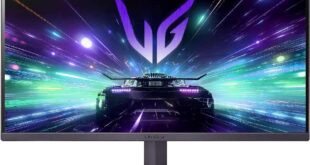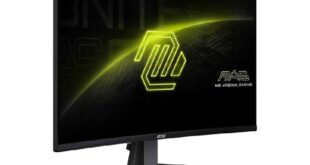Just a year ago, the market witnessed the advent of the first truly computer OLED monitors. In our previous reviews, we explored two of these innovative displays: Dell’s Alienware AW3423DWF and Alienware AW3423DW, both boasting 34-inch QD-OLED solutions. These monitors captured the interest of tech enthusiasts and those craving the cutting edge. However, their larger screen size and resolution of up to 3440 x 1440 pixels may not be suitable for everyone. Fortunately, these concerns can be addressed by opting for the widely popular WQHD standard and a 27-inch diagonal. Introducing the LG 27GR95QE review, featuring a remarkable 240 Hz vertical refresh rate and the latest onboard technology. Without further delay, let’s delve into the details.
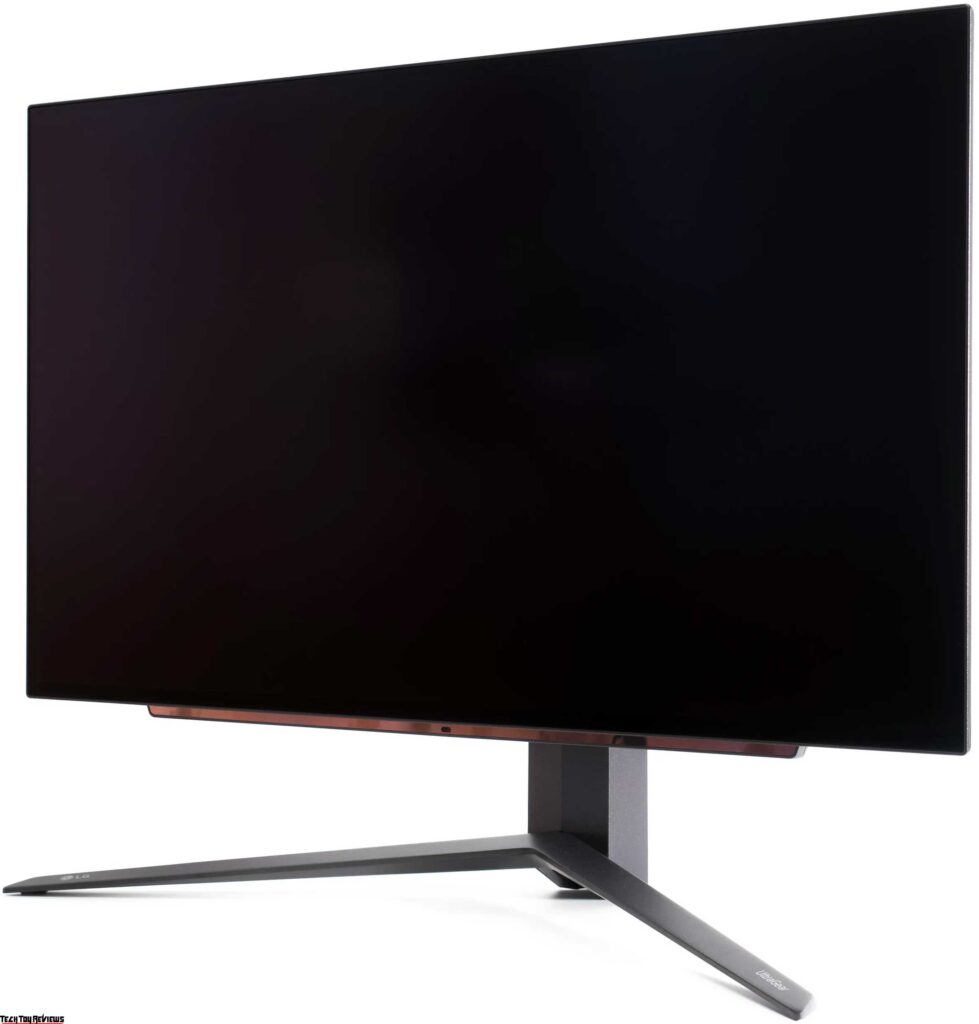
LG 27GR95QE Review
Design and ergonomics
LG has taken a fresh approach to the design of its new-generation monitors. The company has done away with vibrant accents in the form of red decorative elements, opting instead for a semi-gloss “diamond print” and a practical matte plastic body with a hexagonal shape. To add to the aesthetics, LG has introduced the Hexagon Lighting RGB backlight system.
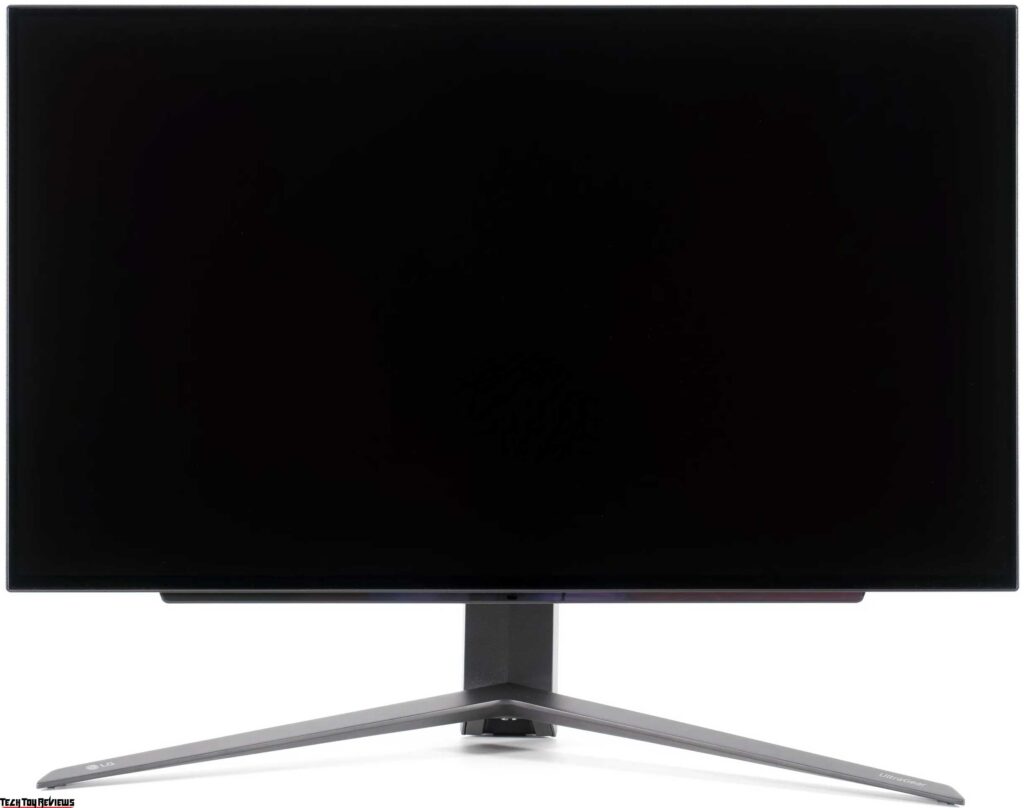
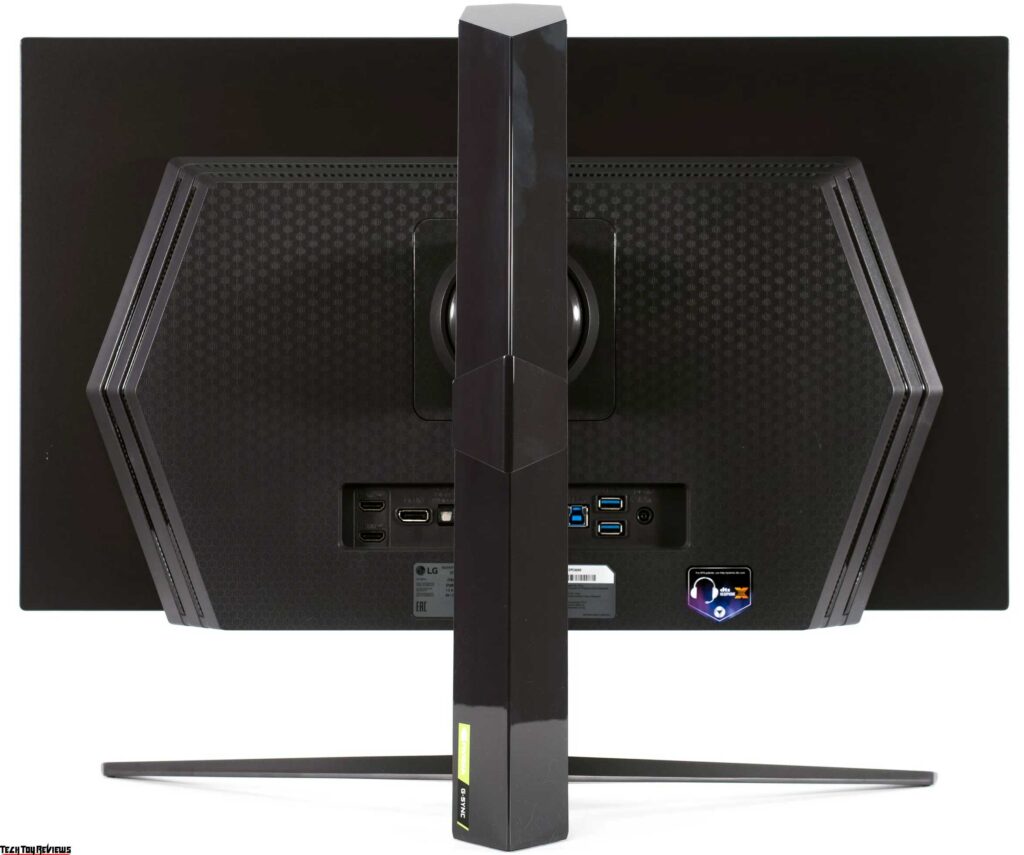
The shift from black plastic to dark gray with a subtle purple-blue hue has resulted in an improved quality of materials and assembly. In essence, this LG monitor belongs to the top-tier category, reminiscent of similar solutions we saw a few years ago.
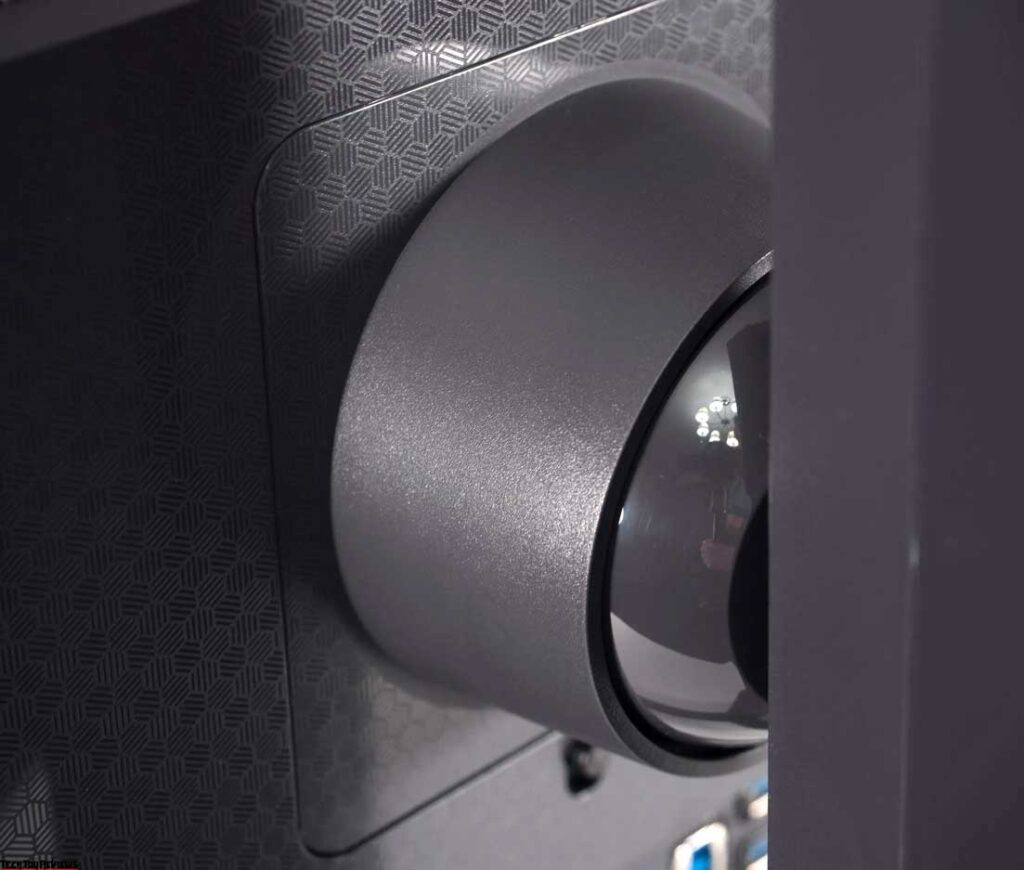
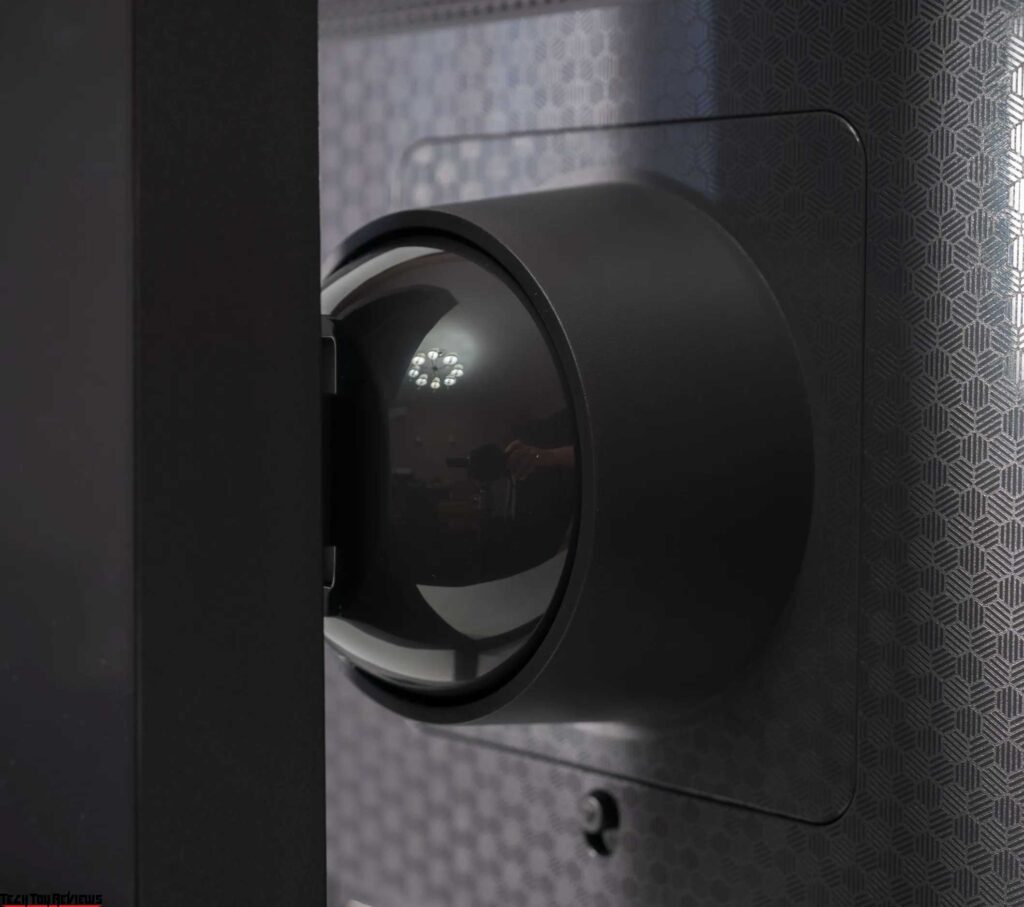
When it comes to OLED monitors, LG has gone above and beyond. The stand itself is crafted from metal, featuring a raised central portion that creates an eye-catching angle between the two legs. The thickness of the inaccessible parts of the casing has been minimized, highlighting yet another advantage of OLED technology. Additionally, a strip with embedded sensors has been added to the bottom edge.
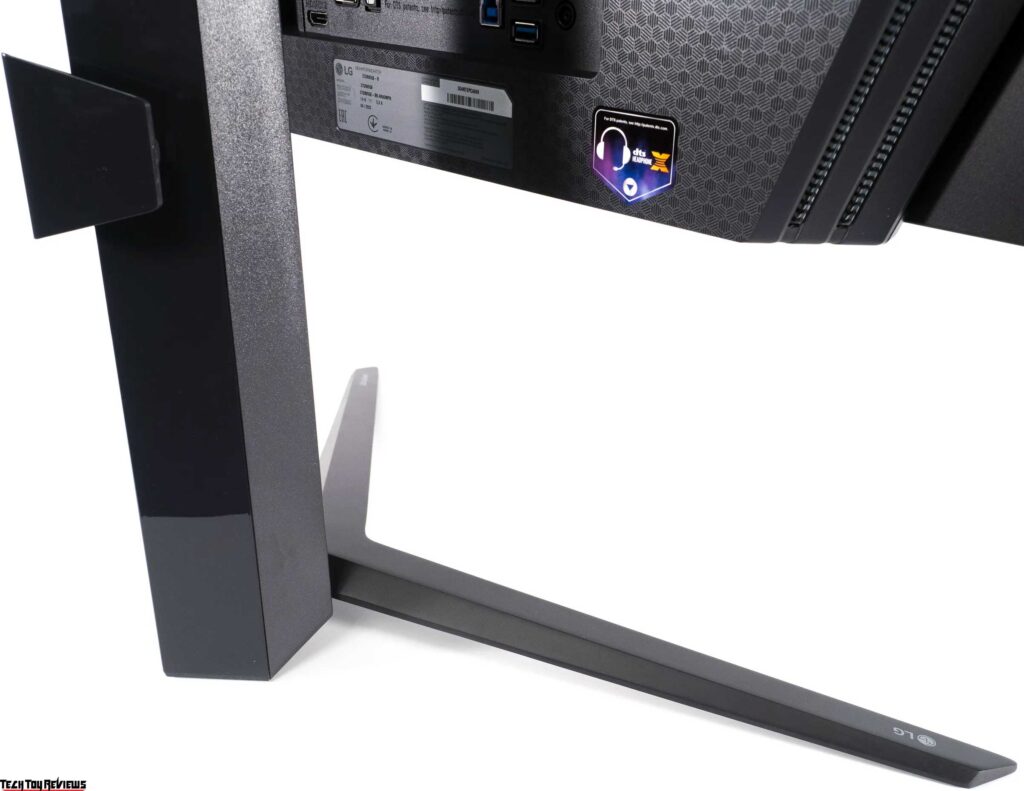
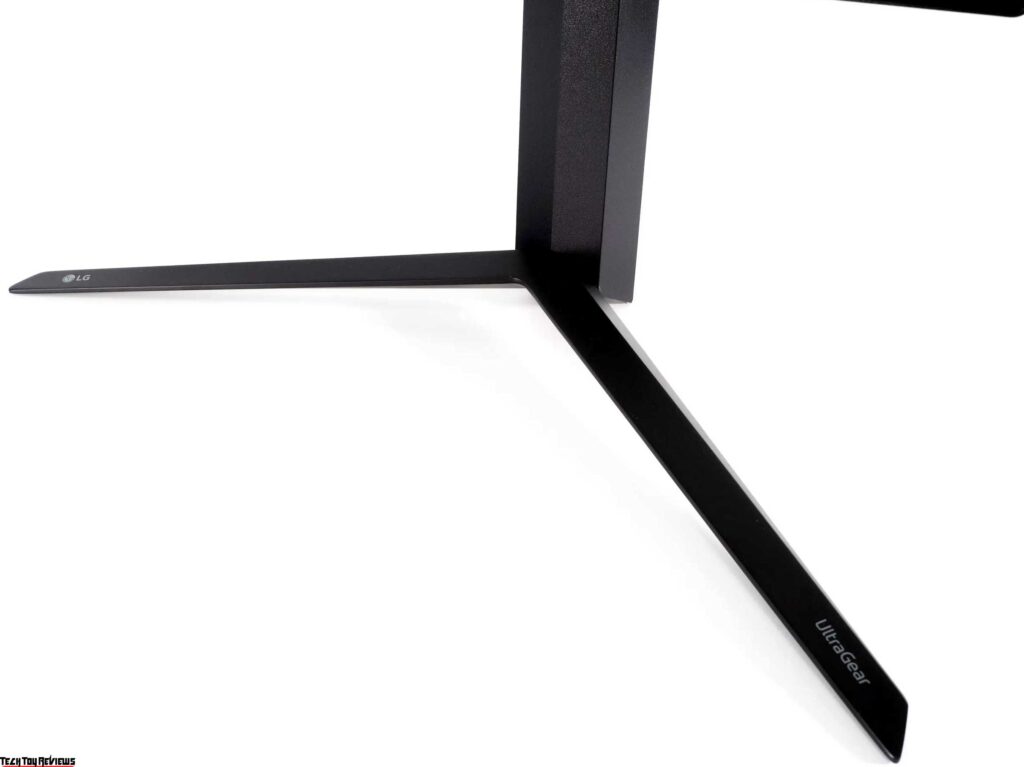
Compared to its counterparts with a similar screen size, the new LG 27GR95QE-B exudes a more luxurious and premium aura. The body is noticeably thicker and heavier, reminiscent of larger 31-32-inch LCD monitors. To enhance cooling, a fan is incorporated, which becomes discernible only in an exceptionally quiet room or when focusing on the upper air intake grille located at the rear of the monitor.
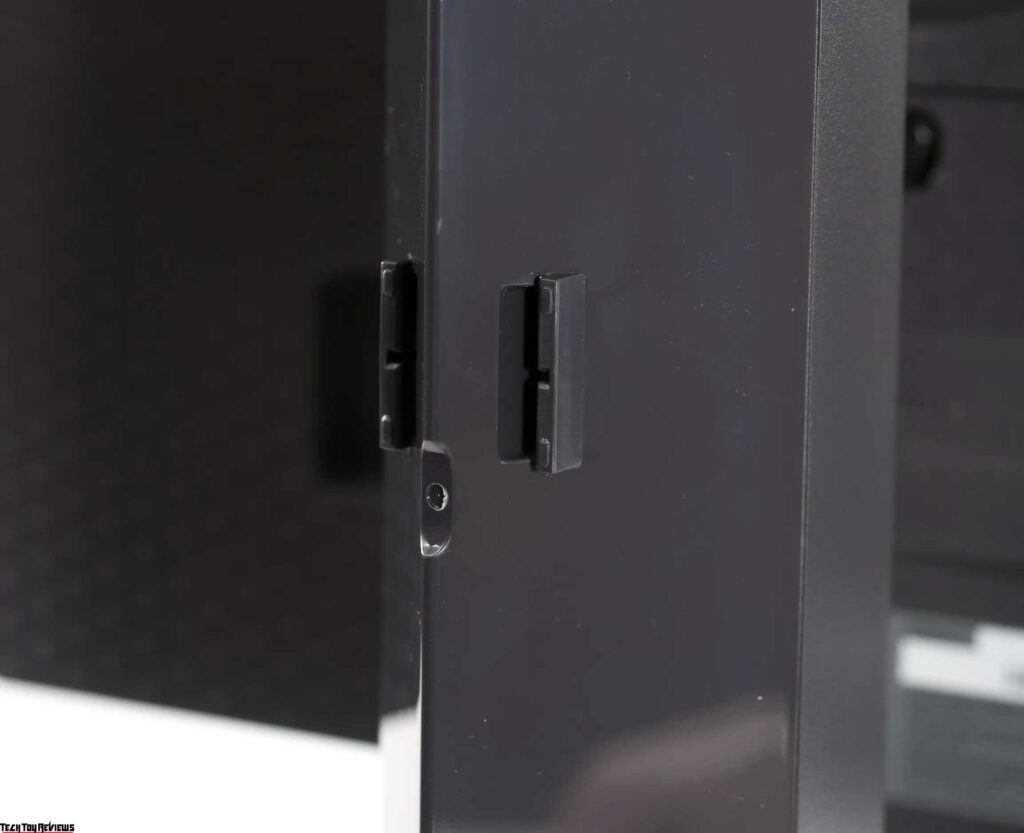
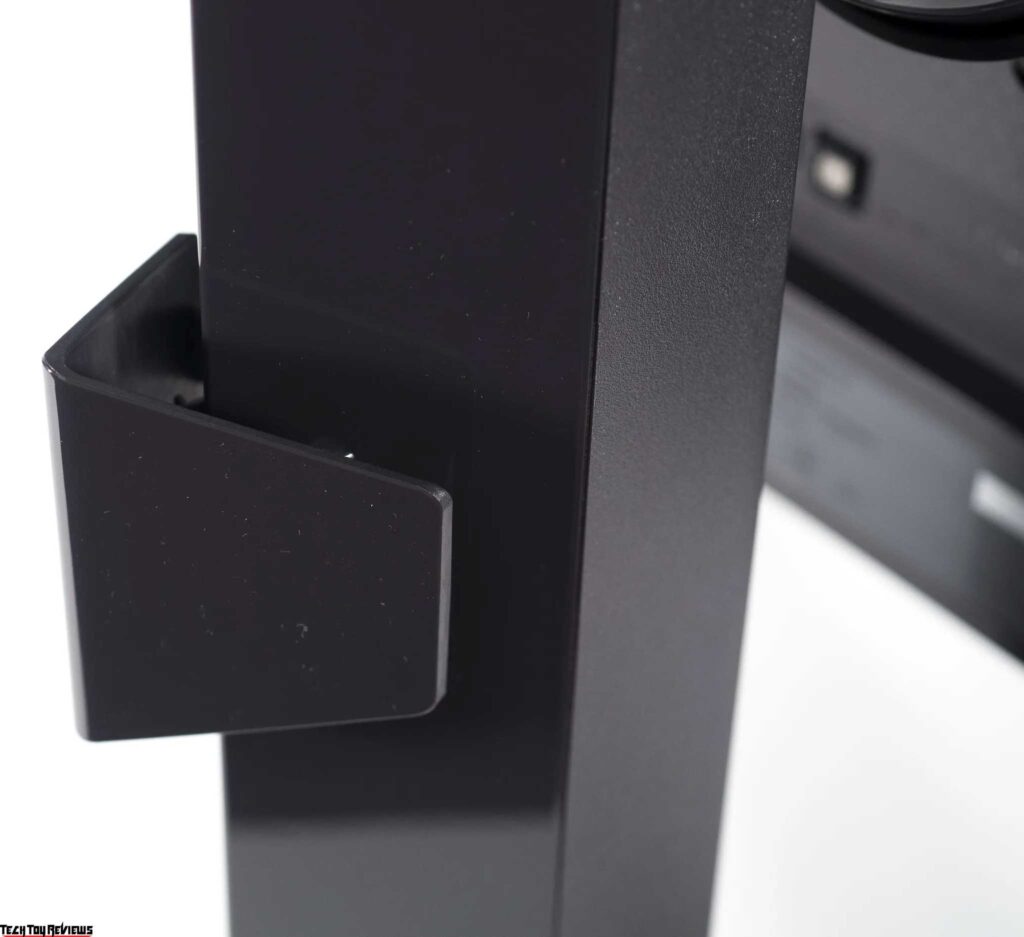
Throughout our LG 27GR95QE review testing, we hardly noticed the presence of the fan. It neither caused any irritation nor varied its tone or speed in response to any load on the monitor.
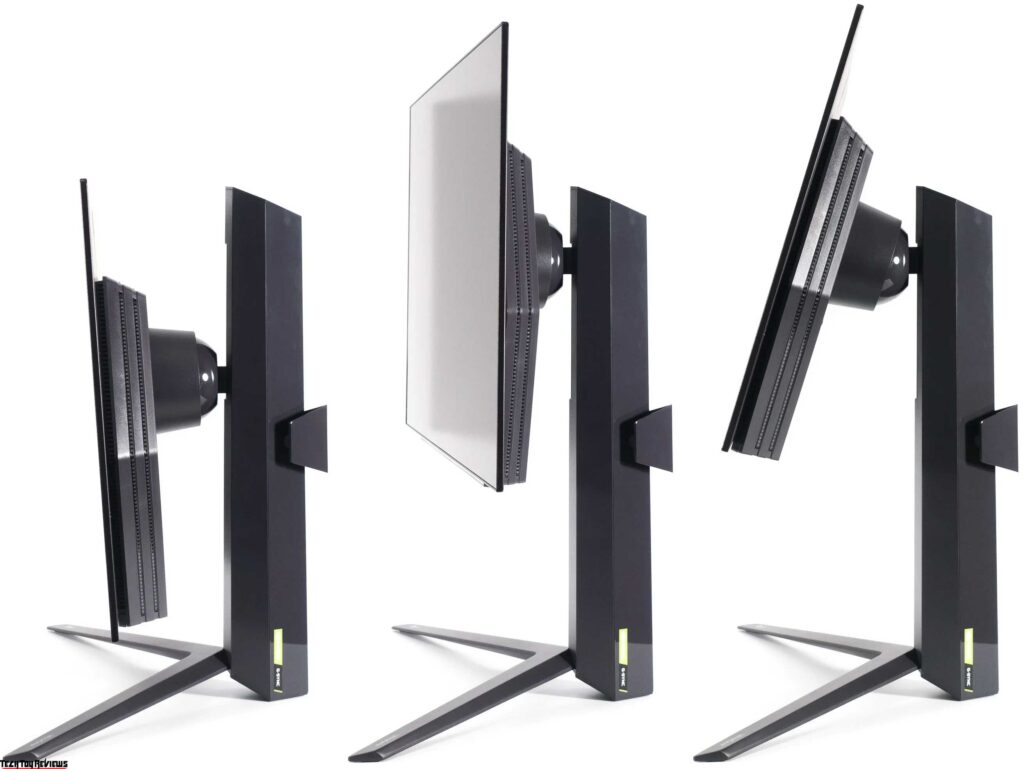
The LG 27GR95QE-B showcases a familiar Y-shaped stand design, which has been subtly updated for a refreshed look. The central column seamlessly connects with the monitor body in a matter of seconds. The outer hinge boasts a glossy finish. Moreover, the case features a recessed VESA-compatible 100×100 mm standard mount that can be easily disconnected by pulling down the plastic lever. The simplicity and clarity of these mechanisms are evident.
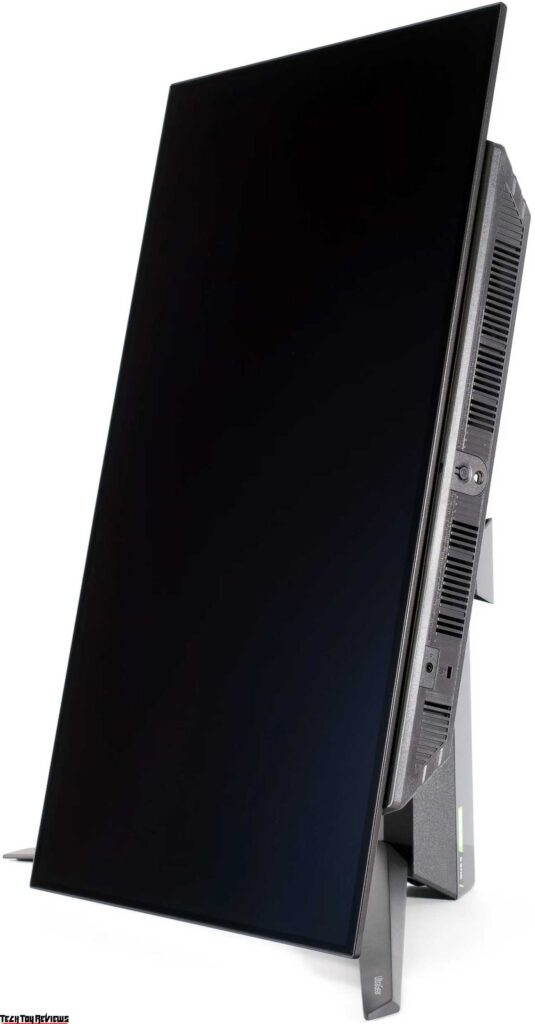
In terms of cable management, LG has made changes to the 27GR95QE-B. The manufacturer has reintroduced an additional fastener, improving the overall system.
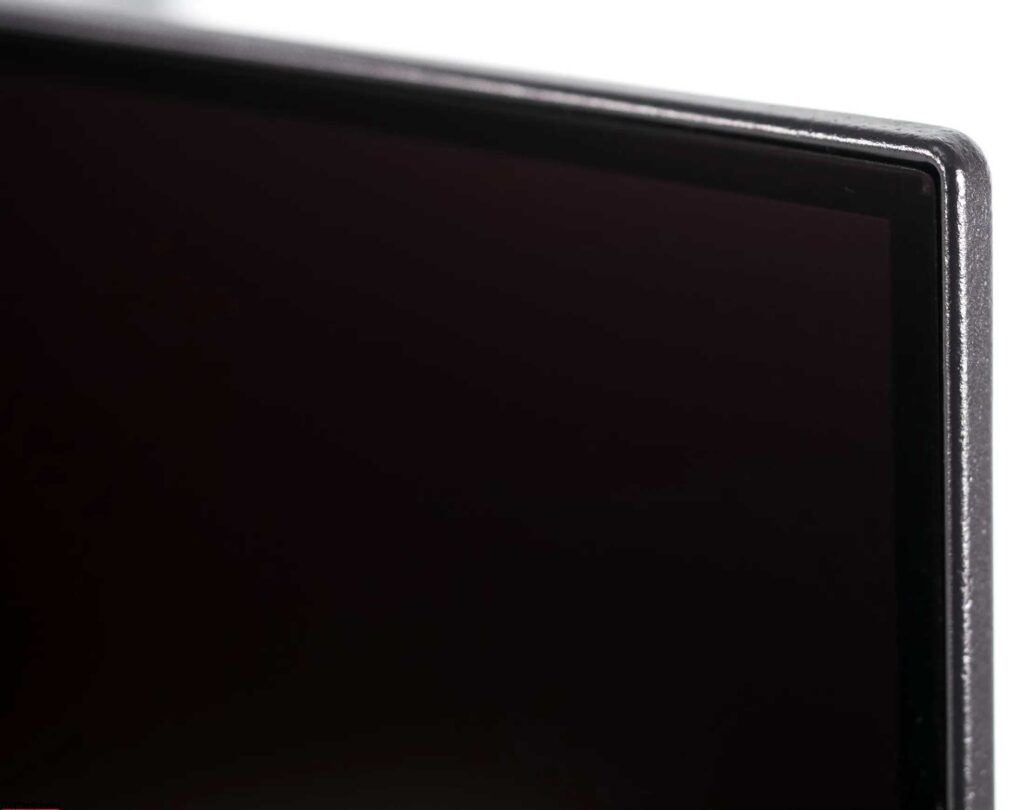
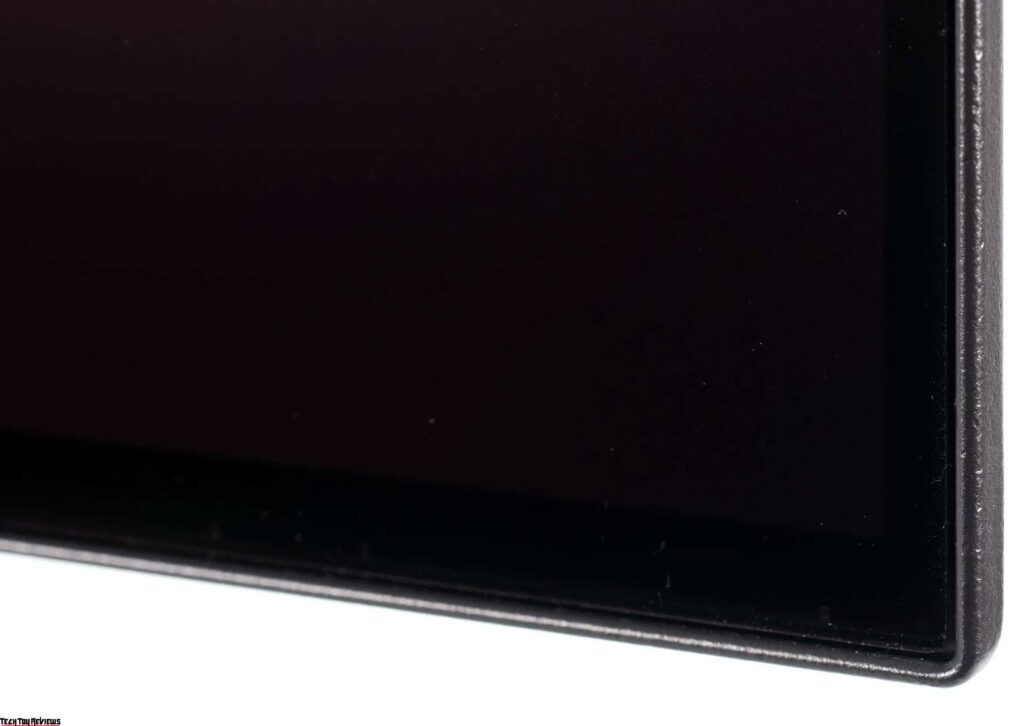
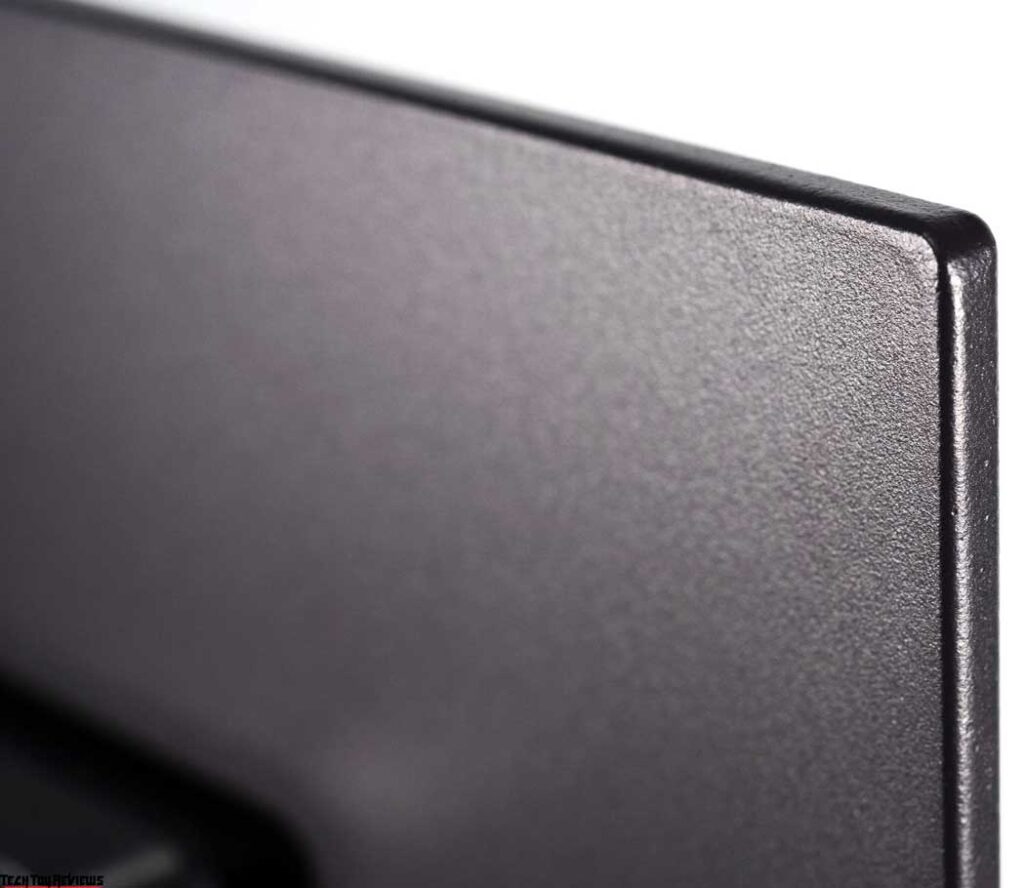
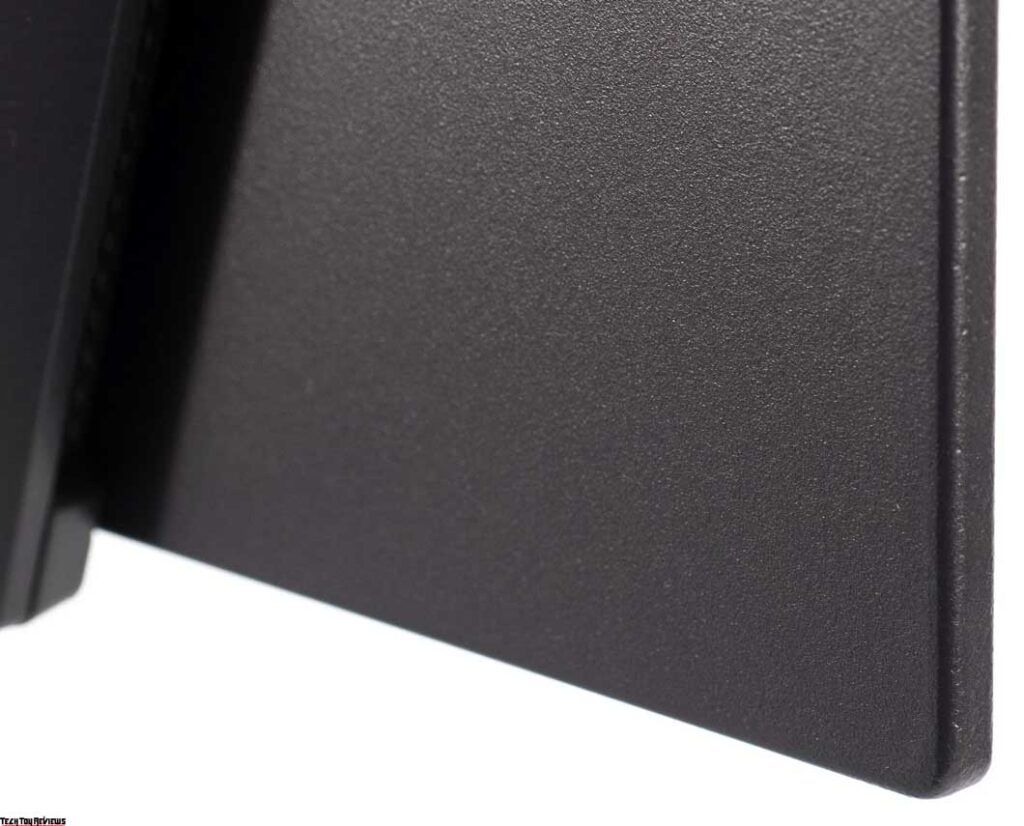
Compared to previous LG monitors, the ergonomics of the stand have been expanded for the LG 27GR95QE-B. It offers a panel tilt range of -5 to approximately +15 degrees, a height adjustment of 110 mm, and a 10-degree rotation to the right or left. However, the Pivot system only supports one direction, enabling the monitor to be used in portrait mode.
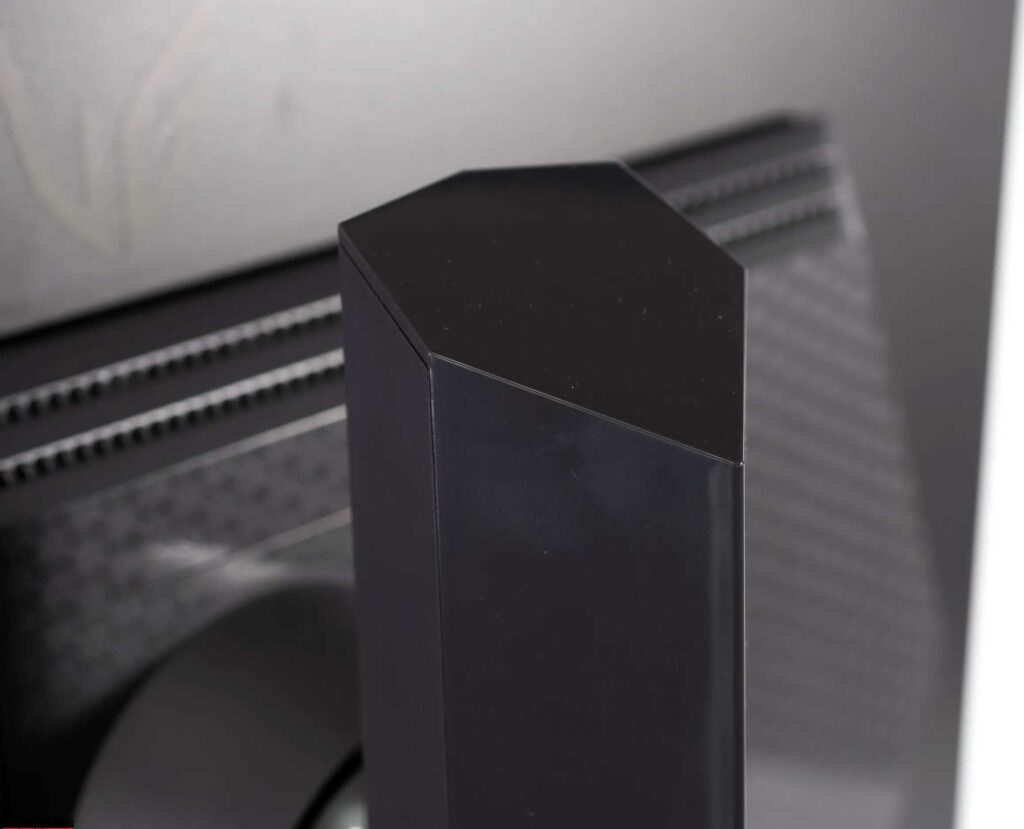
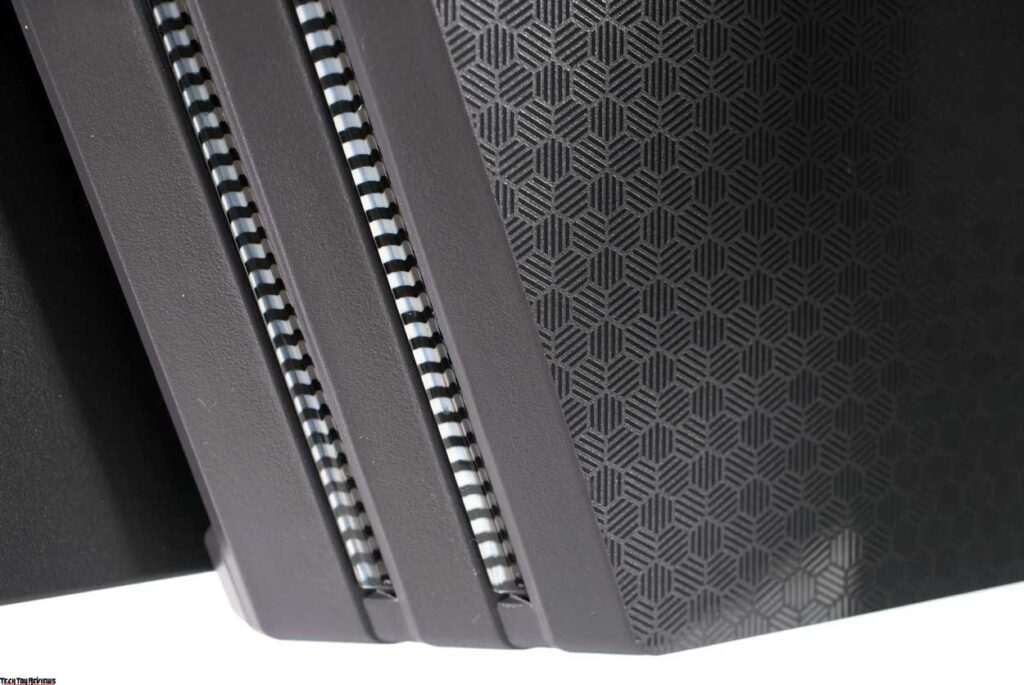

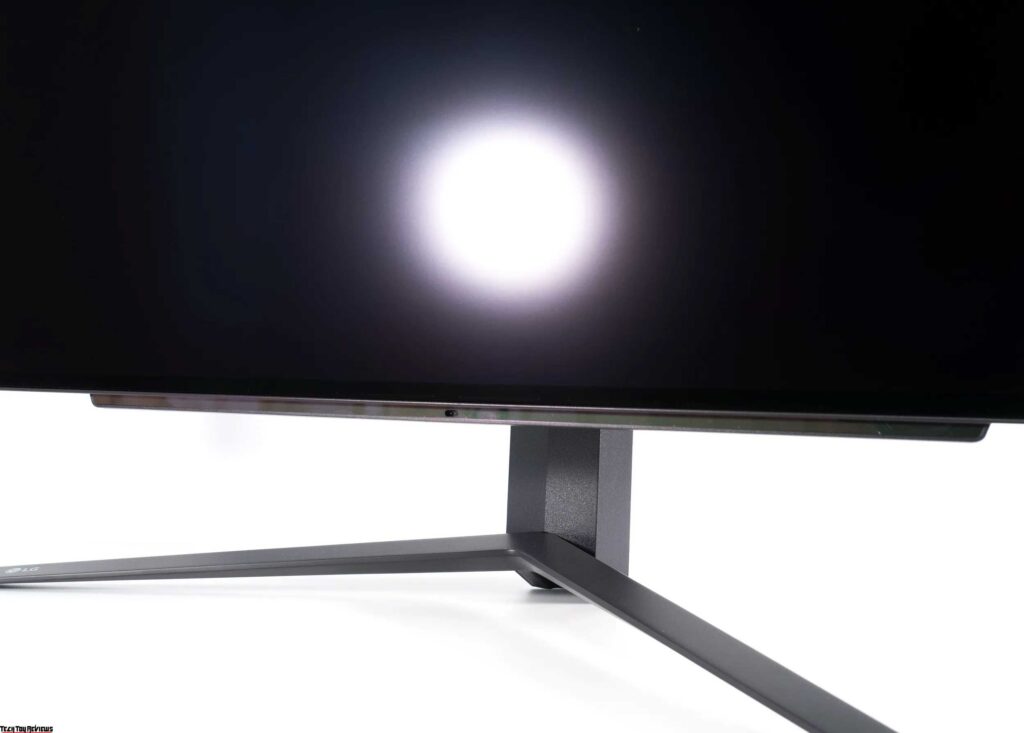
Continuing with the stand, it is worth noting that all fasteners and the structure of the stand itself are made of metal. The monitor is equipped with only three rubber feet, which effectively keeps it in place, yet still allows the option to rotate the display if desired.
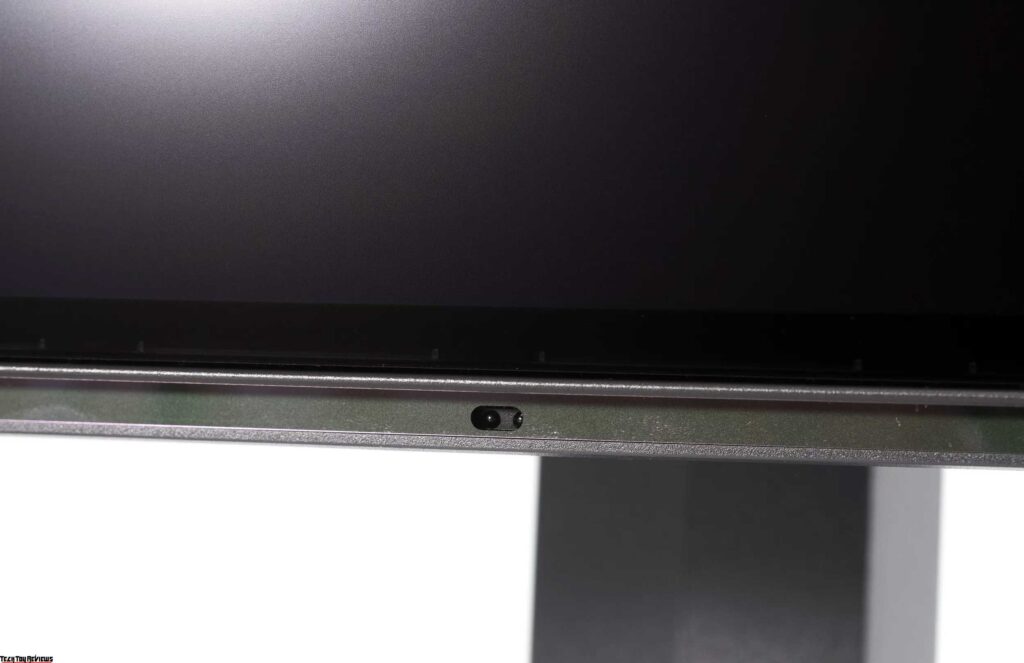
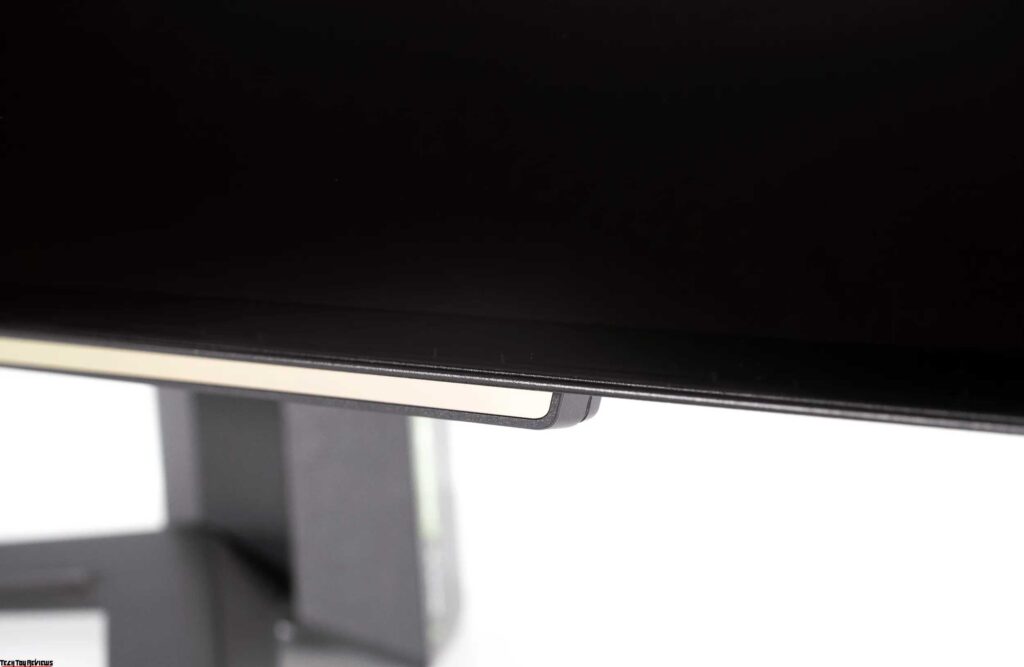
The LG 27GR95QE-B OLED monitor features a matte protective surface on its display. While this surface may exhibit a slight crystalline effect, the monitor’s anti-glare properties are exceptionally strong. This is especially important for users who work in challenging conditions with bright external light sources, such as direct sunlight from a nearby window.
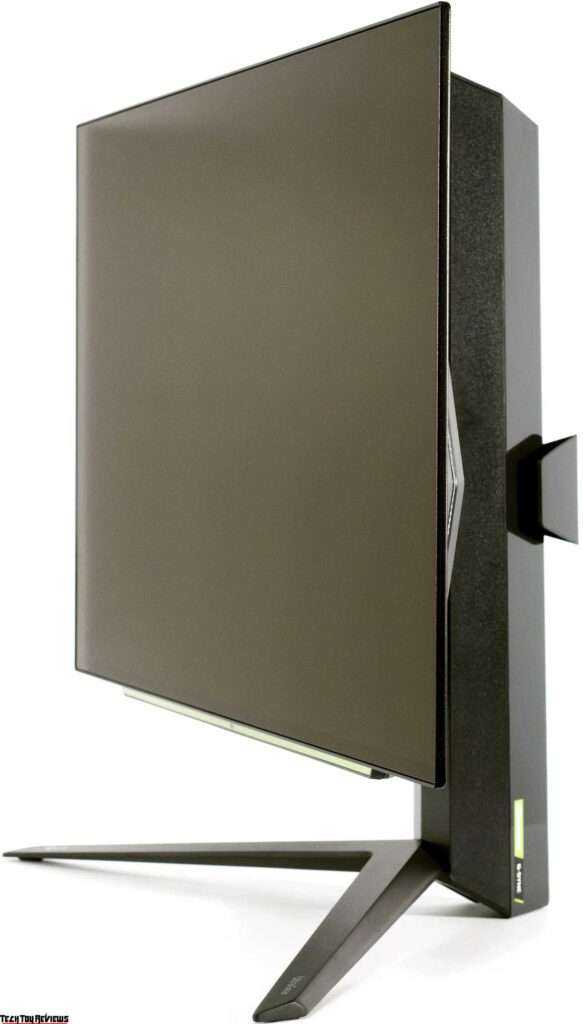
All the connection interfaces are conveniently located at the back of the monitor, directed towards the rear for easy access during setup. Although everything appears familiar, there is one notable change: the inclusion of a fully-featured HDMI 2.1 port with maximum bandwidth. However, visually examining the ports alone would not reveal this upgrade.
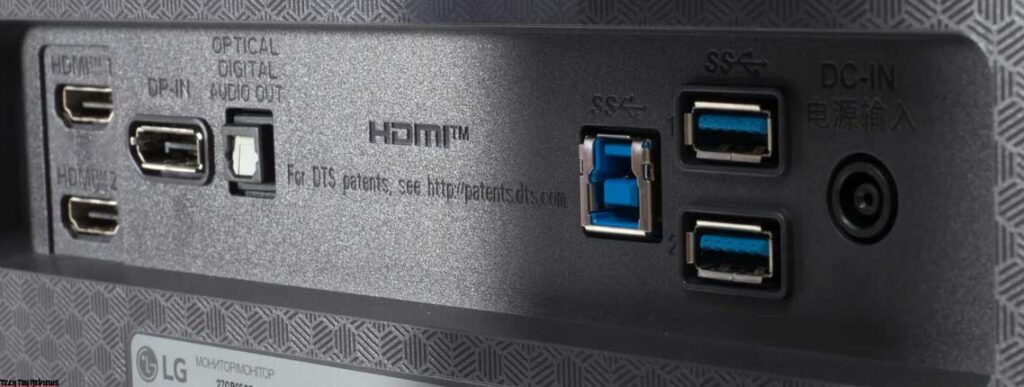
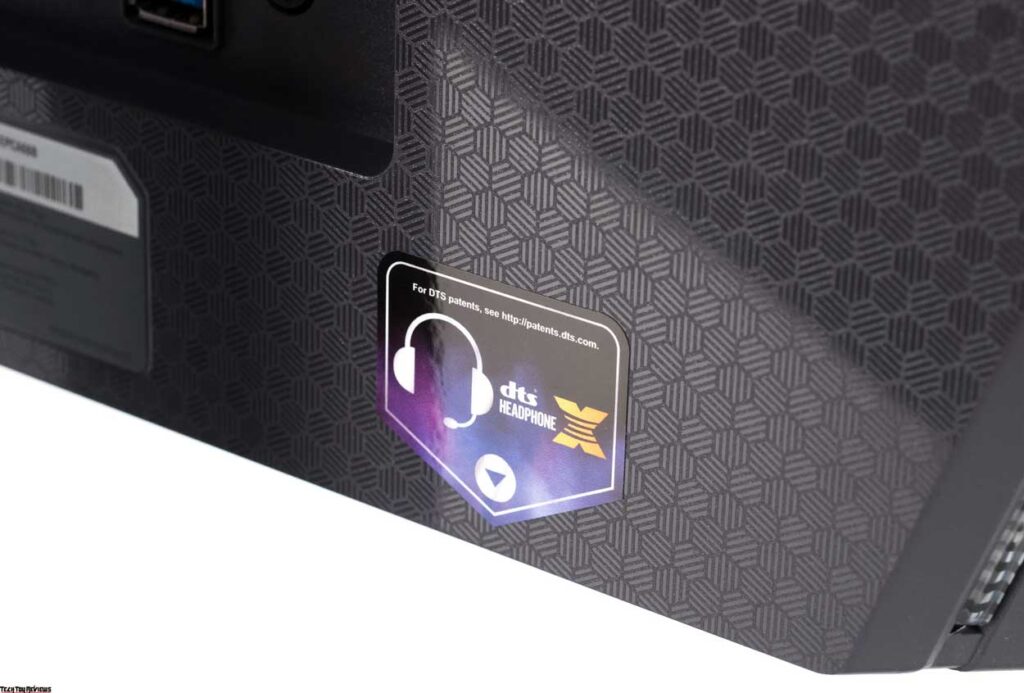
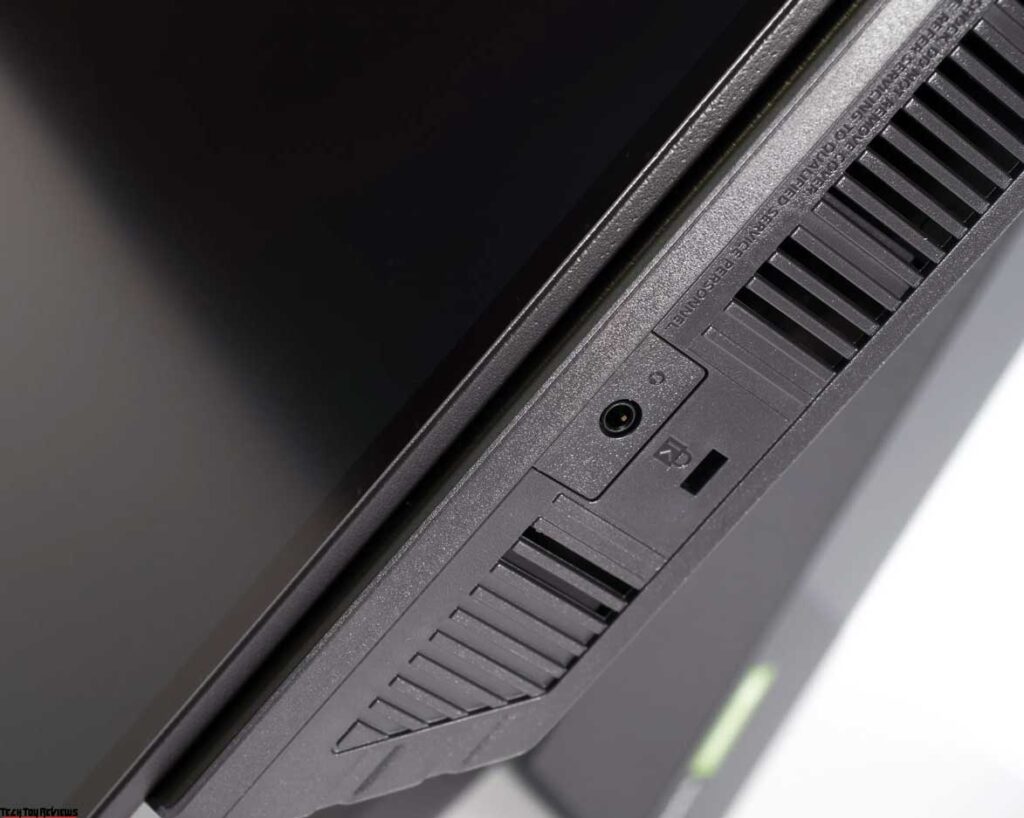
On the bottom of the monitor’s casing, near the control button, you’ll find an additional headphone and microphone output. A sticker affixed to the back of the casing indicates support for the DTS Headphone: X sound standard through this connector.
The monitor does not include a built-in speaker system, as it caters to advanced users who are likely to opt for a high-quality external audio setup or a wired/wireless headset.
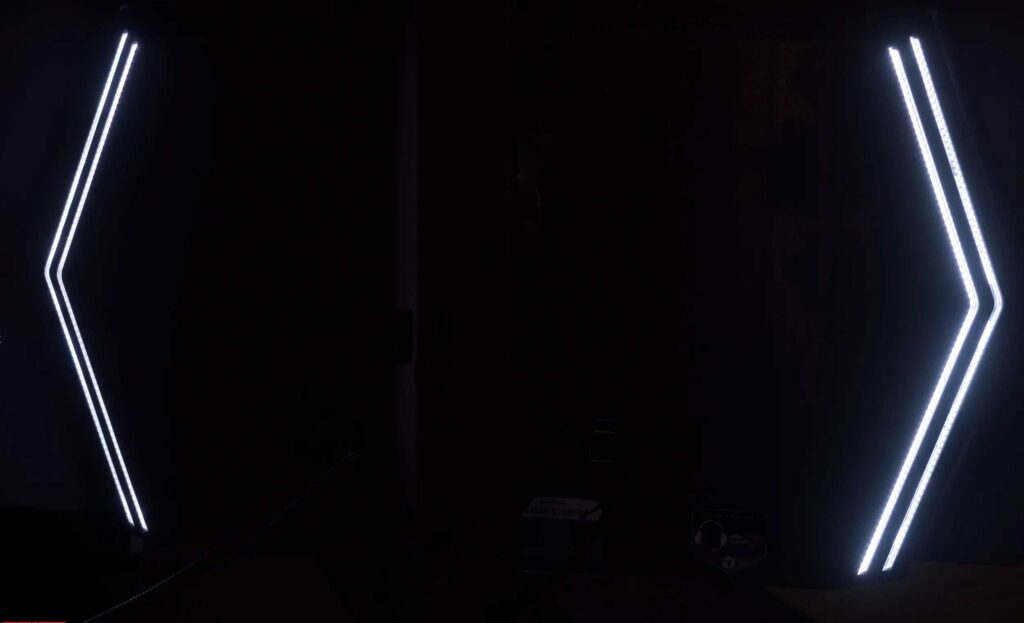
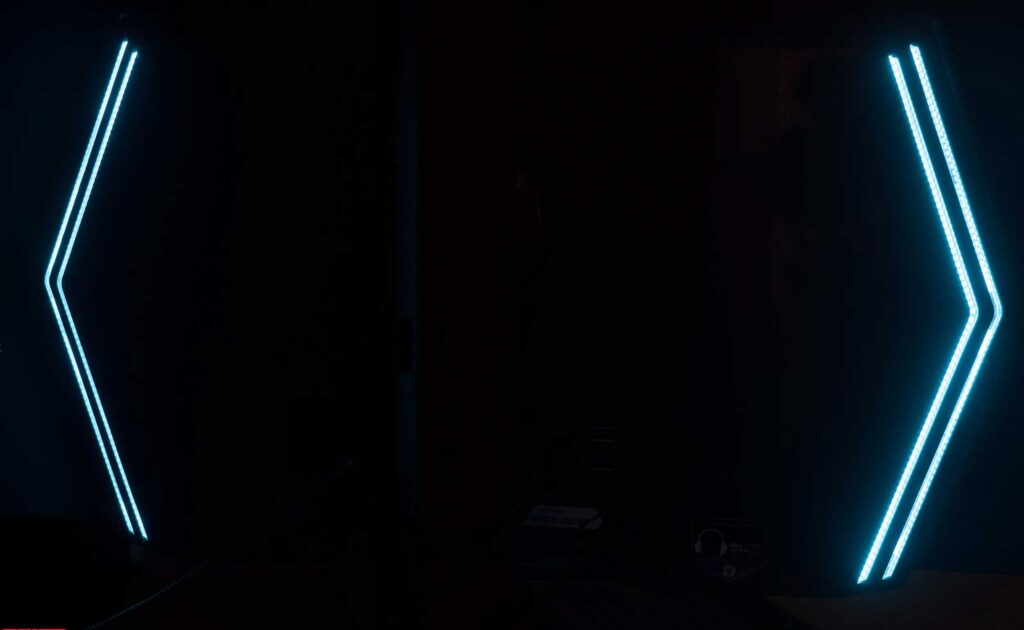
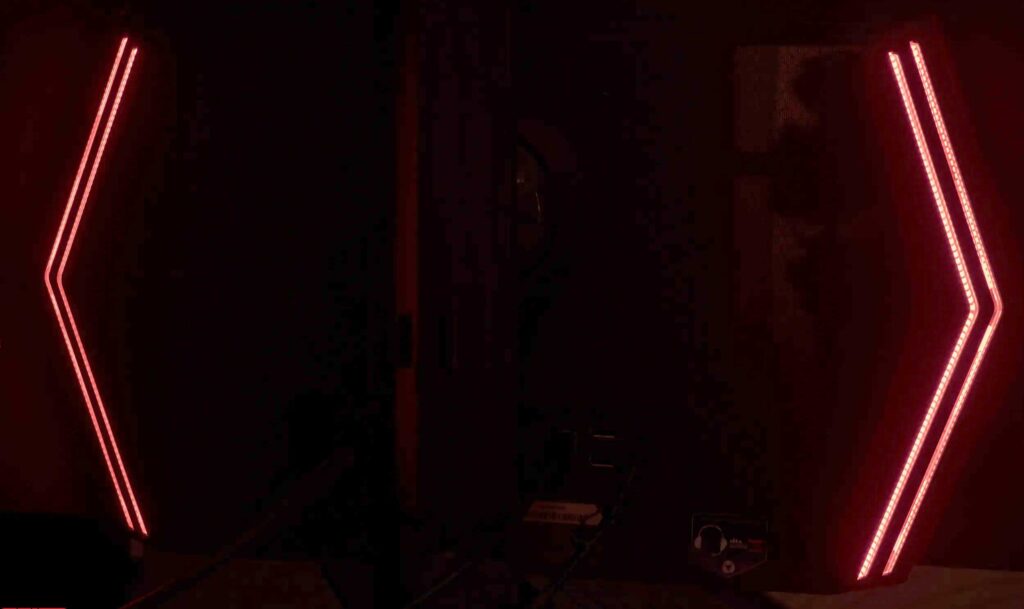
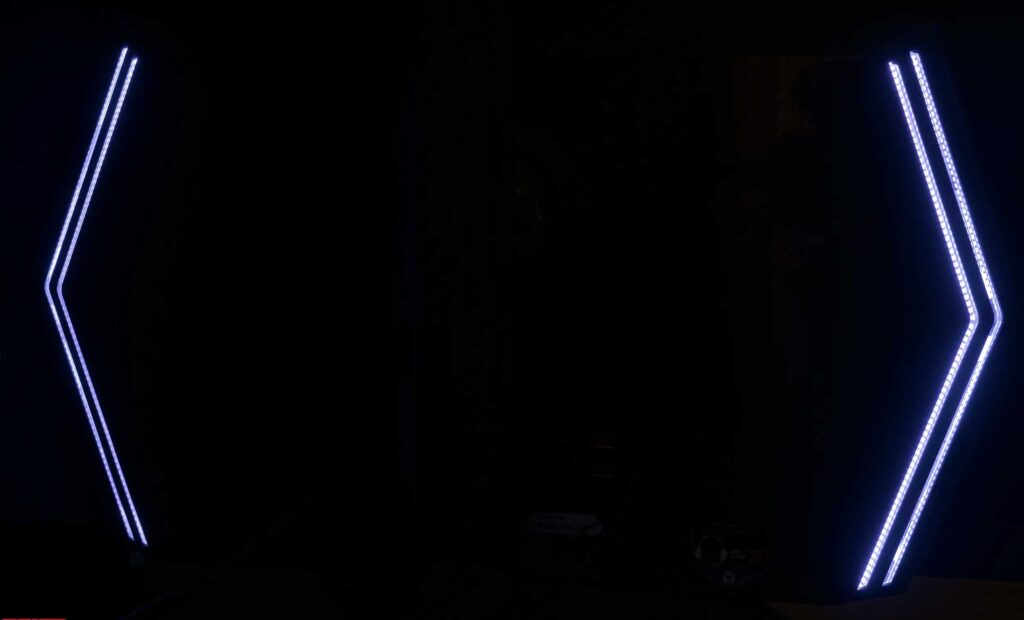
The LG 27GR95QE-B incorporates the Hexagon Lighting system as an external lighting feature. It consists of two sections, each containing two lines of RGB LEDs. This system seamlessly complements the visual changes in the monitor’s design and impresses with its high luminosity. It maintains the same level of visual impact as its predecessors.
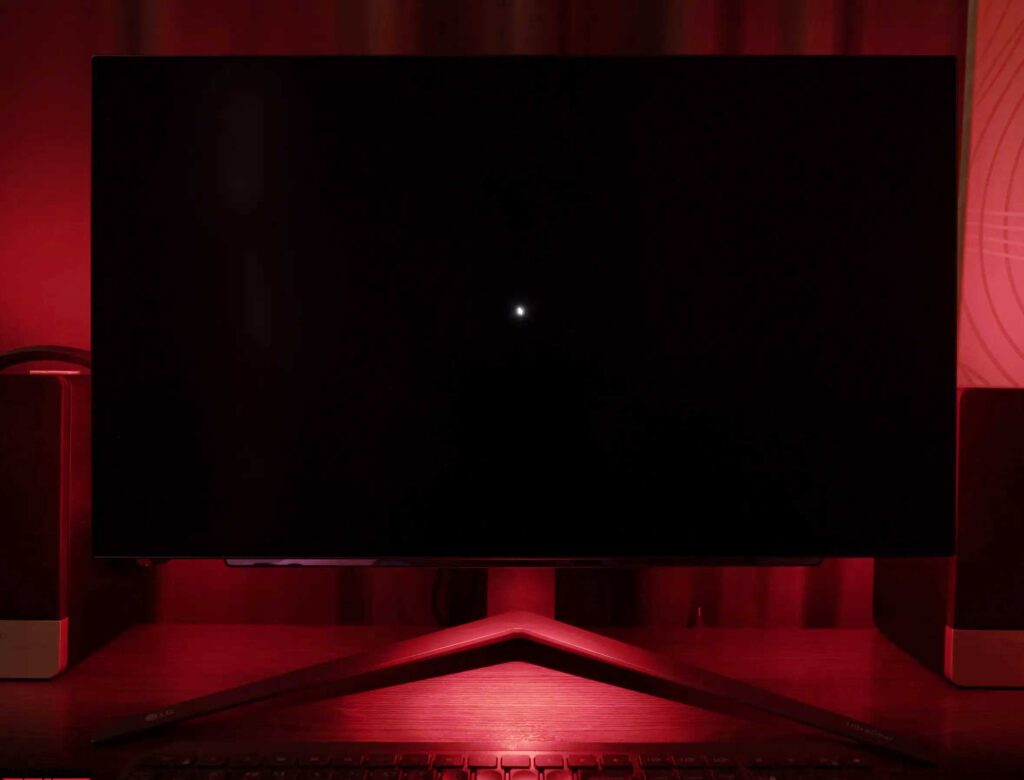
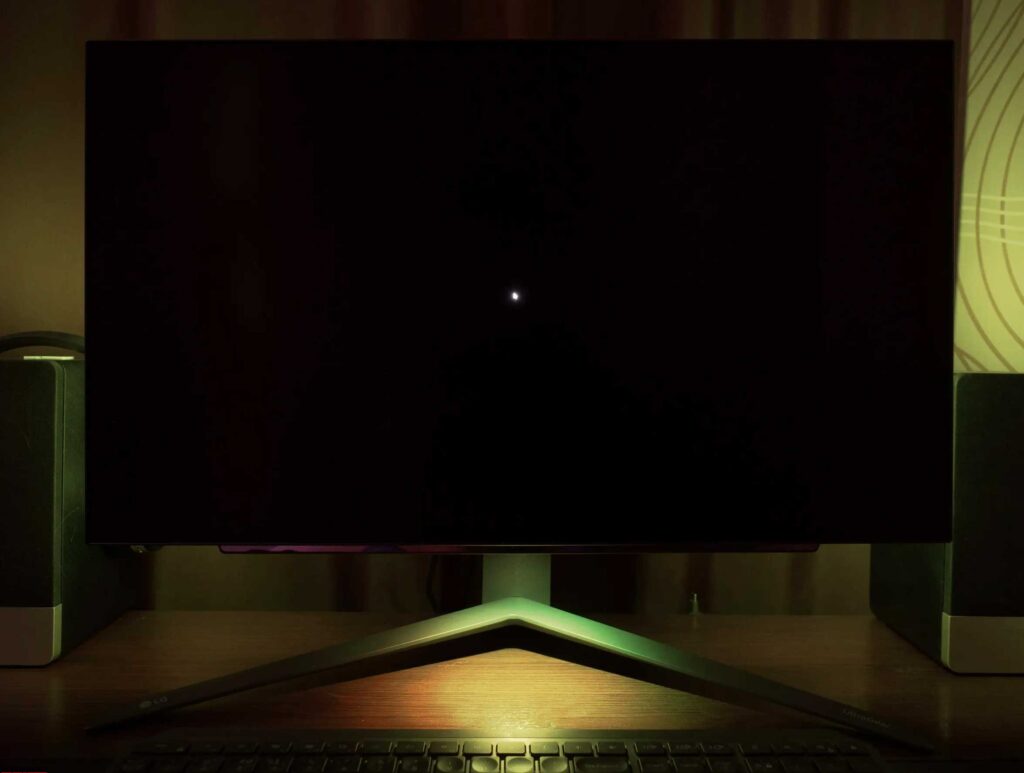
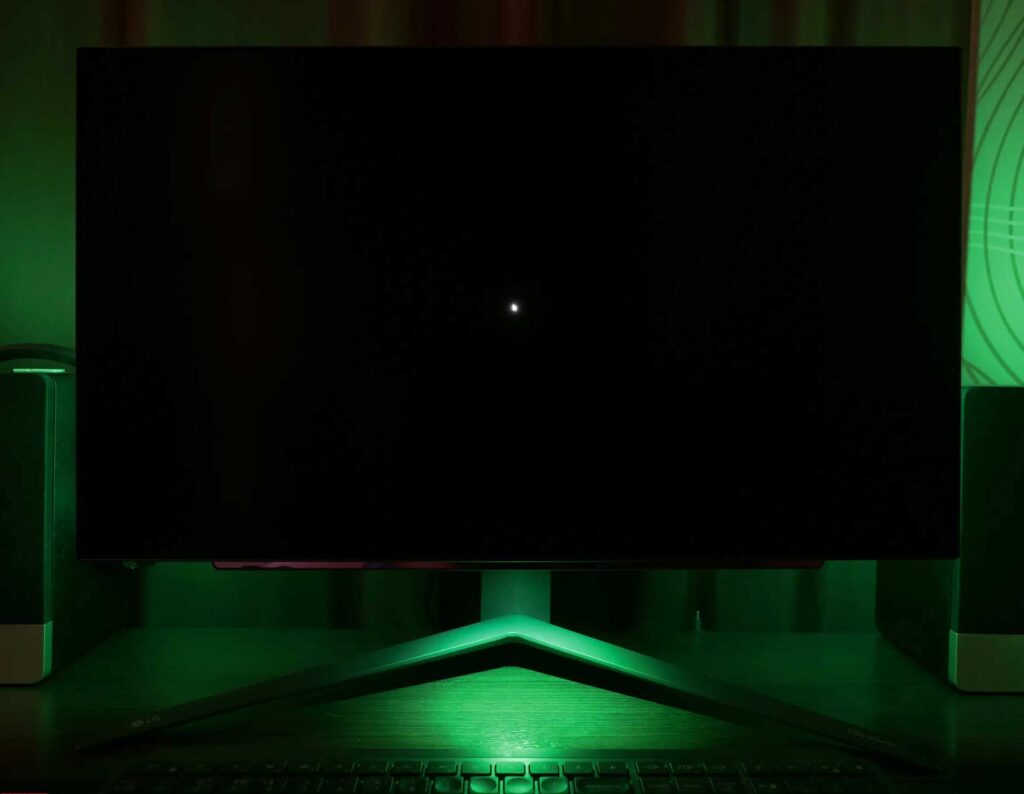
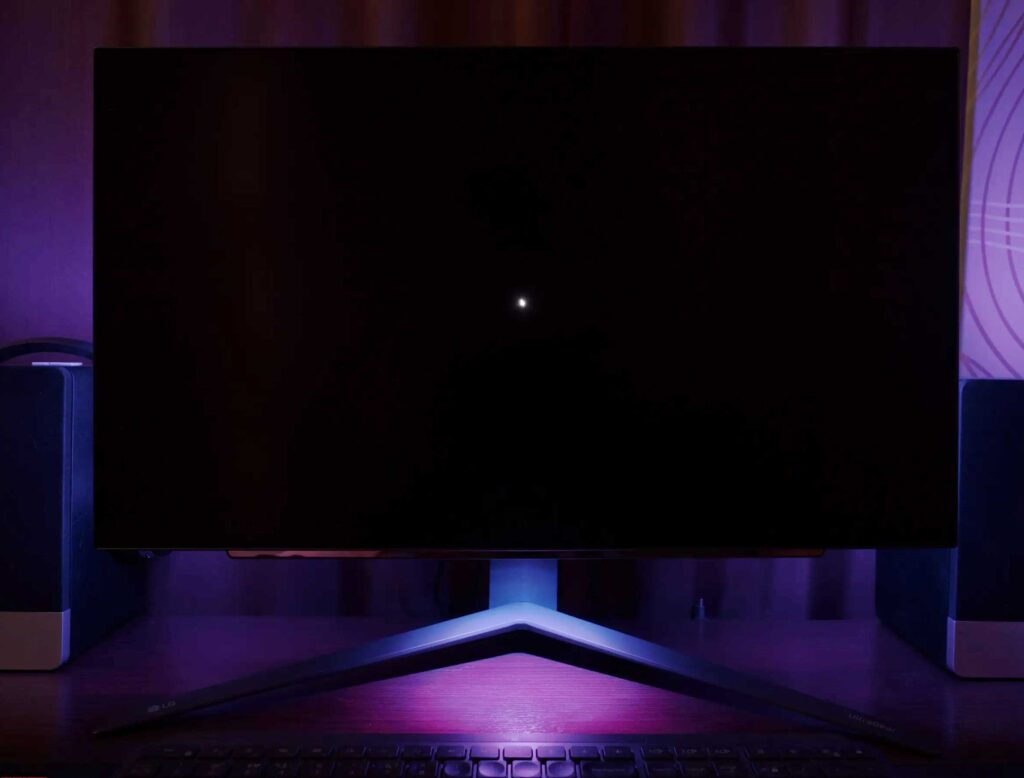
To configure the backlight’s visual range, you can navigate the LG 27GR95QE-B menu or use the shortcut key on the remote control. The Hexagon Lighting system can be customized according to your preference: it can be deactivated, set to a faded color, or fixed to one of the four customizable color options. However, it’s worth noting that in the first case, there are significantly more color gradations available than the default four options. Please consider this fact.
Menu and controls
Let’s delve into the LG 27GR95QE review, shedding light on the changes made to the control mechanism of their OLED monitor. In an unexplained and mysterious move, LG has replaced the conventional 5-way joystick, which has become a staple, with a single control button accompanied by a recessed LED power indicator.
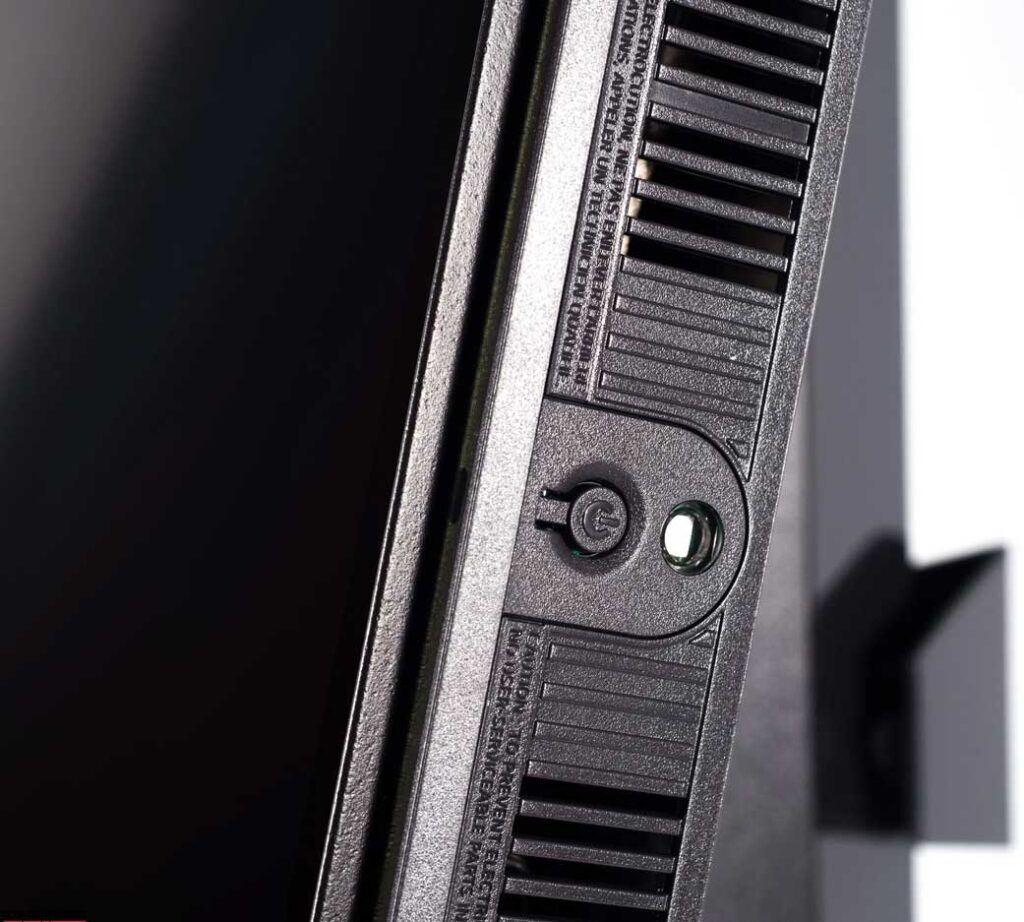
This new control system renders full monitor control without the supplied remote control impossible. The dual-mode key allows users to power the monitor on and off, select the signal source, and adjust the volume and brightness.
To facilitate the adjustment of these parameters, the manufacturer has incorporated two pairs of icons for decreasing and increasing values. While this approach enhances control speed, it still falls significantly short compared to the accessibility offered by a traditional 5-way joystick or dedicated shortcut keys on the remote control.
Speaking of the remote control itself, it is lightweight and compact. The factory-installed battery discharge lock is secured by a plastic insert, which must be removed before using the remote control.
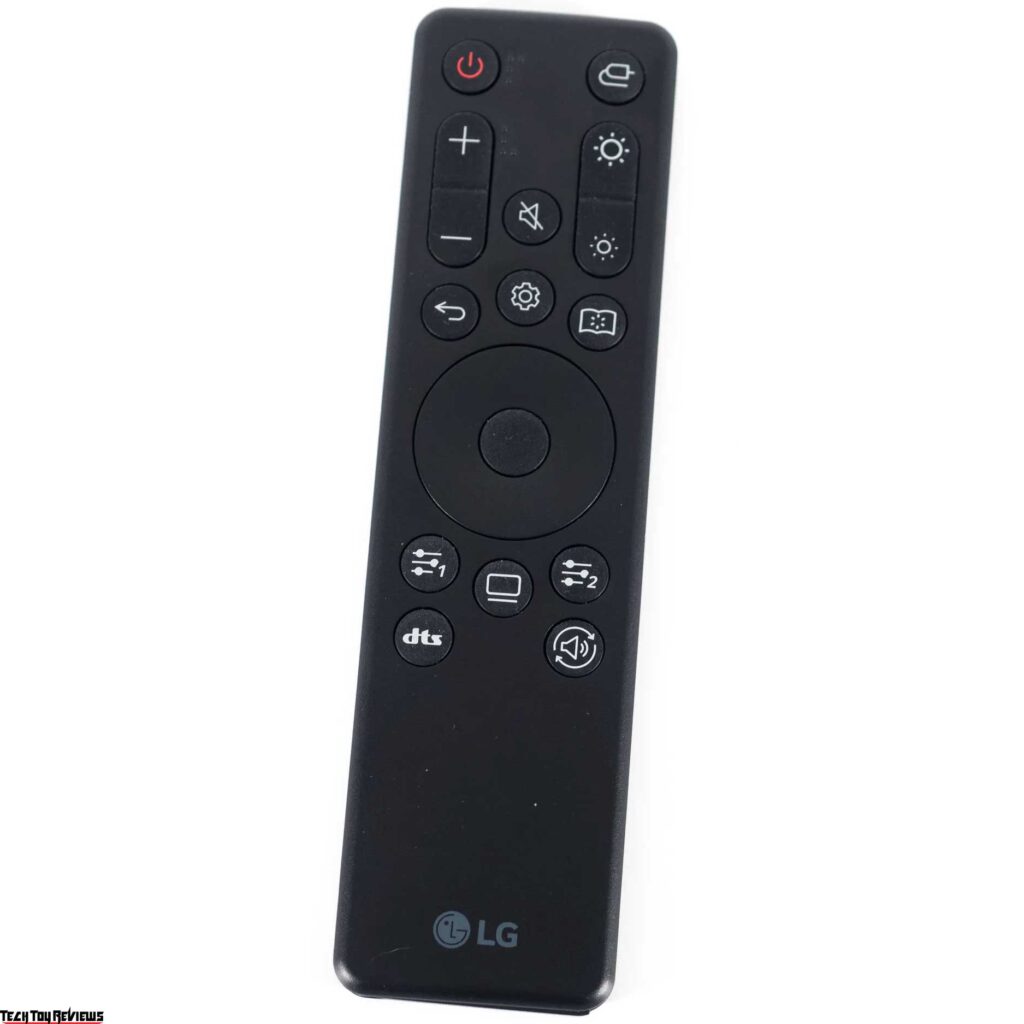
The remote control is equipped with numerous buttons, ensuring ease of use. It provides quick and convenient access to a wide range of functions and monitor settings. These include volume and brightness adjustments, external RGB backlight customization, game settings, preset mode selection, equalizer mode for the 3.5 mm audio output, signal source selection, OLED Care settings, “Reading” mode activation, main menu navigation, and more.
Visually, the menu design showcases LG’s latest accomplishments in this aspect. The colors and fading effects are tastefully executed, with a notable absence of conspicuous red hues. While the menu interface may not be as seamless and swift as desired, it stands as one of the finest implementations of a gaming monitor menu that we have witnessed firsthand in the LG 27GR95QE review.
LG 27GR95QE specifications
- Display: 26.5-inch OLED panel, Anti-Glare, Low-Reflection of the front polarizer
- Color Gamut: DCI-P3 98.5% @ CIE1976
- Color Depth: 1.07B
- Pixel Pitch (mm): 110.8 PPI
- Response Time: 0.03ms (GtG)
- Refresh Rate: 240Hz
- Aspect Ratio: 16:9
- Resolution: 2560 x 1440 (QHD)
- Brightness: 200 cd/m² (SDR) / 1000cd/m²(Peak/HDR)
- Contrast Ratio: 1500000:1 (Typ.)
- Viewing Angle: 178º (R/L), 178º (U/D)
- Features: NVIDIA G-Sync Compatible, AMD FreeSync Premium, Black Stabilizer, Dynamic Action Sync, Crosshair, Smart Energy Saving, Reader Mode, HW Calibration Ready, Color Calibrated, OnScreen Control, HDR10, HDR Effect, Auto Input Switch, FPS Counter, 4-Side Virtually Borderless Design, User Define Key, VESA DSC, VRR, RGB LED Hexagon Lighting, True Color Pro, DTS HP:X
- Ports: HDMI x 2, DisplayPort x 1, Headphone Out 4-pole (Sound+Mic), USB Up-stream (1ea/ver3.0), USB Down-stream (2ea/ver3.0), SPDIF out
- Stand: Tilt (-5º ~ 15º), Swivel (-10º ~ 10º ), Height adj. (110mm), Pivot
- Dimensions: 23.8″ x 22.6″ x 10.2″(Up) 23.8″ x 18.3″ x10.2″(Down) (with stand)
- Weight: 16.2 lbs (with stand)
- Accessories: Power cable, External power supply, Remote control with integrated battery (can be replaced), Plastic element of the cable management system, Display port cable, HDMI cable, USB cable for PC connection, Quick Setup Guide, Booklet with additional information, Warranty card, Booklet with additional information on the product, Booklet with configuration options (depending on the sales market), Energy efficiency labels, Factory calibration report (short version)
LG 27GR95QE review test
Display
The LG 27GR95QE-B monitor incorporates a W-OLED panel with a WBGR pixel structure. Unlike the traditional RGB sub-pixel arrangement, this panel adds a “white” sub-pixel and reorders the remaining three sub-pixels. Adding to this configuration is the presence of a matte protective surface on the matrix.
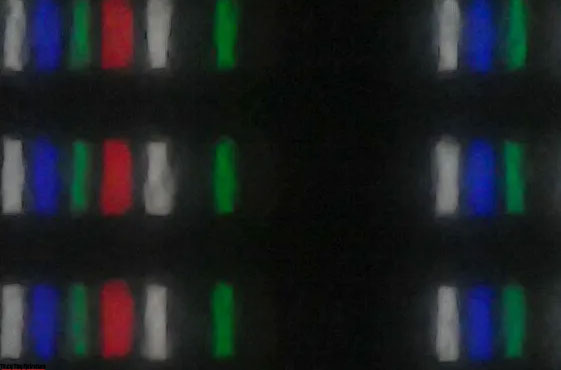
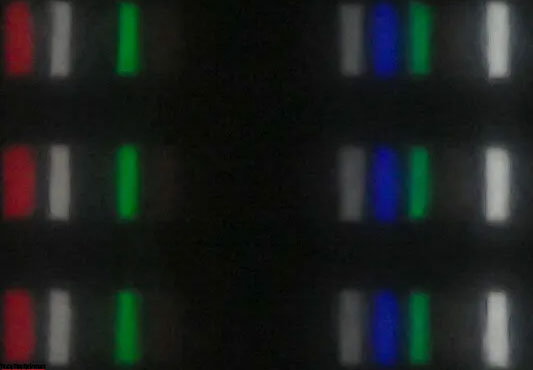
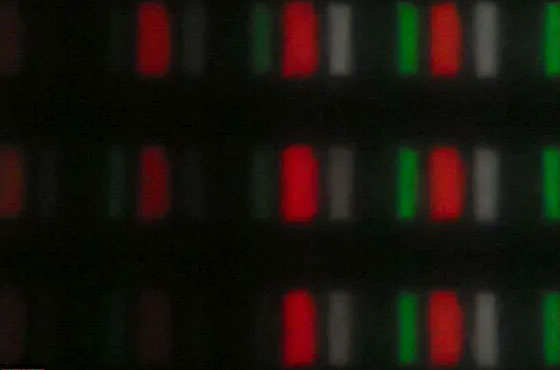
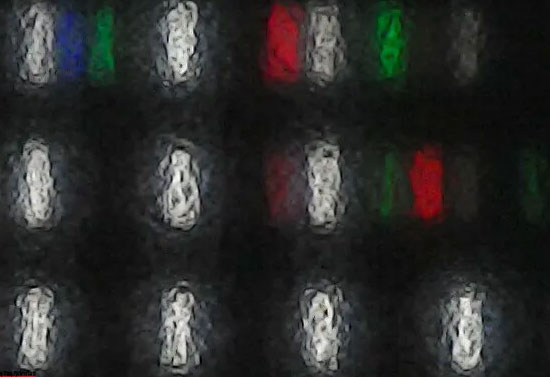
From the macro photos above, you can observe the pixel structure and the protective film. These shots focus on different areas of the same image segment. It’s worth noting that with this pixel structure, the simultaneous operation of all sub-pixels is an exceedingly rare occurrence and generally impossible in real working conditions behind the screen.
Consequently, the clarity of fonts on our LG 27GR95QE review model is not optimal. Various color artifacts or color contours may be visible, leading to increased eye strain and quicker fatigue. We do not recommend using such OLEDs for prolonged text-intensive tasks.
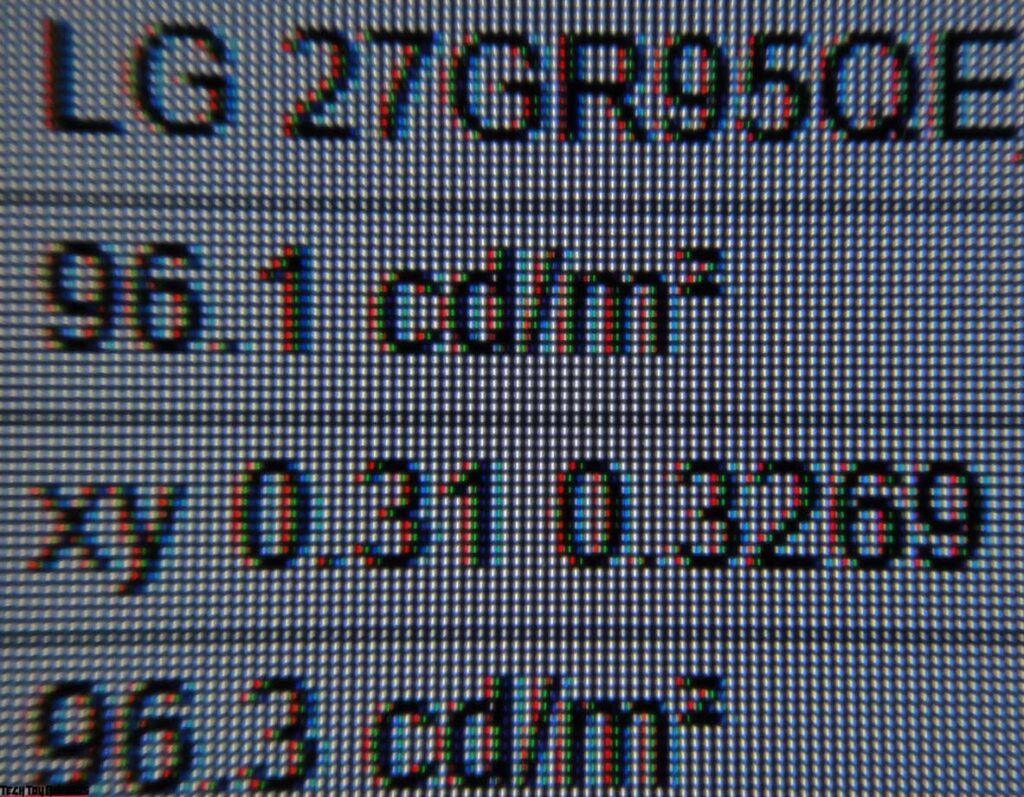

Add to this the distinct crystal effect due to the use of a rough matte protective coating on the matrix, which in turn visually reduces the visual contrast of the image that all OLED fans are chasing. Although the LG 27GR95QE-B lacks the glossiness to deliver the expected “wow effect” of crystal-clear and deep imagery, it’s important to acknowledge that this design choice was a deliberate decision by LG engineers.
Considering the relatively low maximum brightness of OLED displays, it is essential to provide a feature that adjusts the picture brightness based on the displayed content. Opting for a glossy surface, which fails to address glare and reflections, would be counterproductive. From a technical standpoint, the approach taken here is well-considered. However, the manufacturer may have overlooked the aesthetic appeal for the end consumer. It is within their rights to do so!
Color gamut
The 27GR95QE-B boasts an exclusive 26.5-inch LG Display OLED, which currently stands as the only one of its kind with a near-full DCI-P3 wide color gamut. Now, let’s delve into its capabilities based on our LG 27GR95QE review experience:
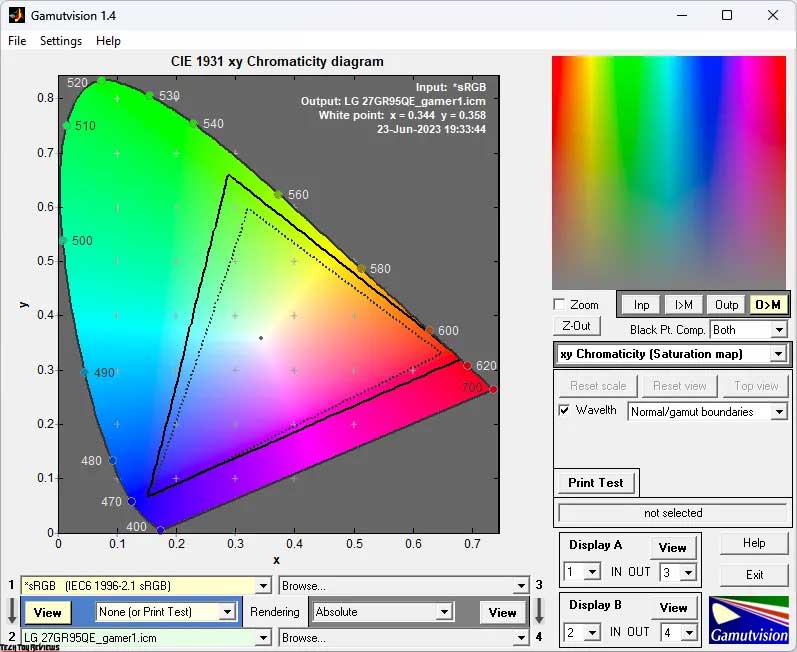
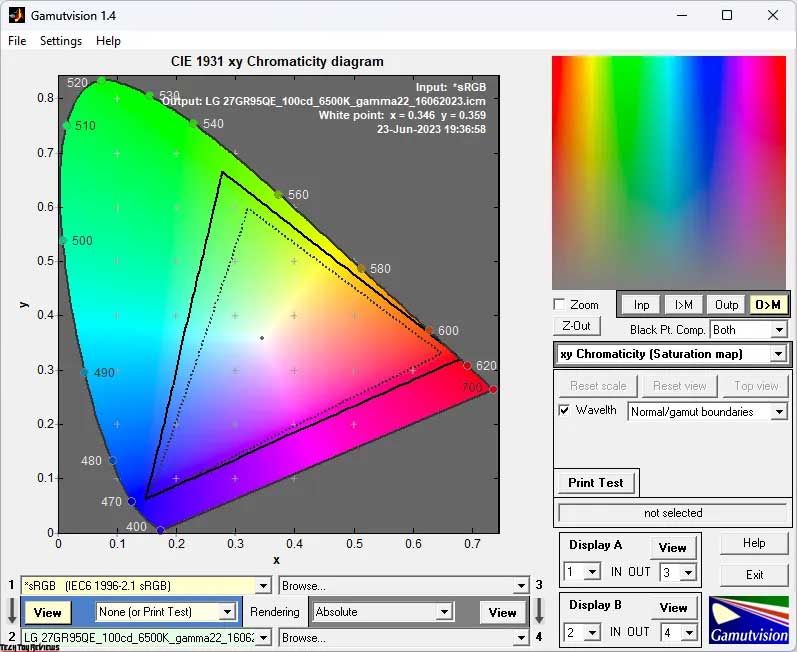
For the initial test, we utilized the factory display settings in Player 1 mode. The accompanying screenshots clearly illustrate that two out of the three reference points deviate noticeably in space from the standard sRGB color standard, surpassing it in various areas. In comparison to the even broader Adobe RGB gamut, the monitor falls behind in terms of green and turquoise mid-tones but exhibits a significant lead in red tones, which aligns with the norm for a modern W-OLED panel from LG Display. Although a standard calibration in this mode yields slight improvements in color reproduction capabilities, it doesn’t offer substantial changes.
In the absence of a color management system profile and compatible software, familiar images, photos, and video sequences will appear with heightened color saturation. This characteristic may appeal to some individuals while displeasing others.
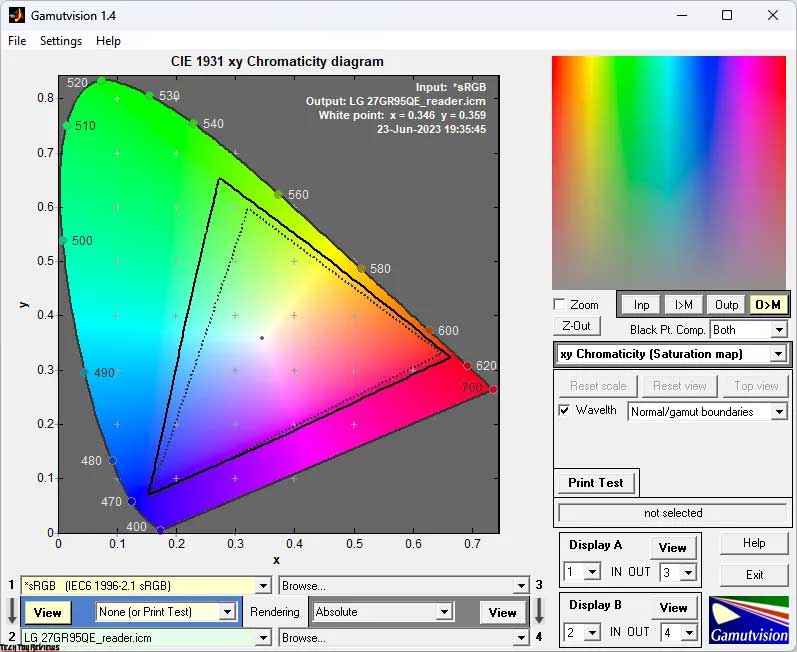
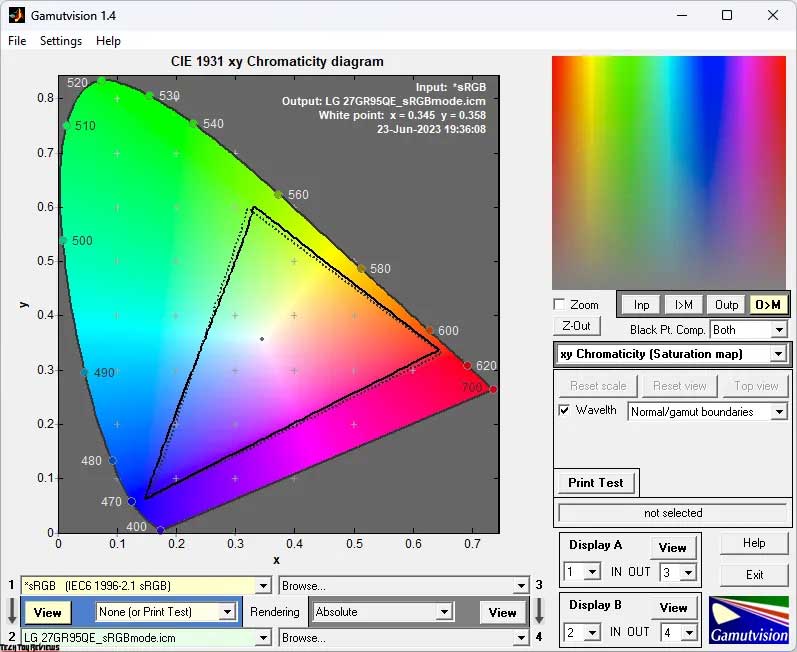
To address these issues, the manufacturer has thankfully introduced an sRGB emulation mode with adjustable brightness and color temperature, catering to regular consumers. However, it’s worth noting that the narrowing of the color gamut in this mode is not entirely accurate (fuzzy borders can be observed on the CIE diagram). Additionally, in the Reading mode, designed to alleviate eye strain, colors retain their oversaturation.
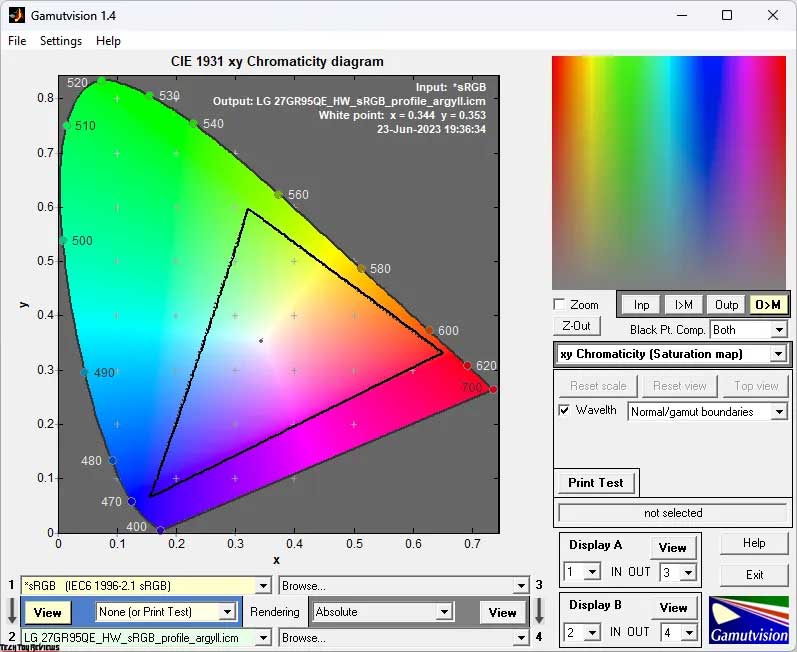
By conducting hardware calibration via the LG Calibration Studio program, we were able to enhance the emulation of the sRGB color space, thereby making its usage somewhat beneficial. However, a few caveats remain.
Below, you will find the final results regarding the monitor’s compliance with standardized color gamuts and the overall amount of color data.
Standard settings (Gamer mode 1):
- sRGB – 99.6|135.5%
- AdobeRGB – 83.6|93.3%
- DCI-P3 – 93.8|96.0%
Reading mode:
- sRGB – 90.2|111.6%
- AdobeRGB – 75.9|76.9%
- DCI-P3 – 75.6|79.1%
sRGB mode:
- sRGB – 92.0|96.4%
- AdobeRGB – 66.2|66.4%
- DCI-P3 – 68.0|68.3%
After hardware calibration (sRGB):
- sRGB – 92.3|93.5%
- AdobeRGB – 64.3|64.4%
- DCI-P3 – 66.2|66.3%
After software calibration (Gamer 1):
- sRGB – 99.7|140.0%
- AdobeRGB – 86.3|96.4%
- DCI-P3 – 94.0 | 99.1%
All measurements were conducted using the Argyll CMS environment, with the exclusion of colors and shades that surpass the reference values. After calibration, the monitor showcased a commendable 94% DCI-P3 compliance, which was consistent with its performance in the factory settings. As for the claimed 98.5% accuracy, it remained more of a theoretical achievement, aligning with expectations and approximately matching the results obtained by various reviewers employing different measurement tools.
Regarding the management of excessive shades that surpass the studied standards, it is worth mentioning that you can address this matter using the familiar method of utilizing ICC/ICM profiles and software that adequately supports the color management system (CMS). Notable examples include Adobe products, FastStone Image Viewer, XnView, Windows Photo Viewer (7, 8, 10, 11), Firefox, Google Chrome, and more.
Brightness, contrast, and color ratios
Out of the seven preset modes available on the monitor, we have selected the three most significant and intriguing ones. Furthermore, we have included the “Calibrated 1/2” presets (HW-Calibrated in the table below), which involve hardware correction performed through separately provided software from LG. By default, the “Player 1” mode is utilized with the following settings:
- Brightness: 100
- Contrast: 60
- Color temperature: User (50/50/50)
- Gamma: Mode 2
- Black stabilizer: 50
Let us now delve into the results depicted in the table below:

During the LG 27GR95QE review test, we aimed to showcase its capabilities in the best possible manner. To achieve this, we deliberately restricted the measurement area to 10% of the screen, employing a solid background as the working black backdrop—knowledge gained from experience with OLED monitors.
In the factory mode, the Player 1 preset delivered a brightness of 201 nits, but the white point approached 9000K, resulting in a visually cold image, which is expected at such a color temperature. This setting did not surprise us, as the manufacturer explicitly mentioned that the 8000-9000K range represents the “level of precise factory calibration” for this monitor. It was implemented to enhance the screen’s maximum brightness by intensifying the brightness of additional “white subpixels” without employing a color filter atop them. While the picture’s contrast is appropriately set, there are some challenges regarding overall color accuracy due to not precisely adhering to the DCI-P3 standard.
In the “Reading” mode, accessible through a dedicated button on the remote control, the screen brightness is significantly reduced (though it can be manually adjusted) to a more suitable level. The color temperature remains around 5300-5400K, and the black point is elevated to the extent that the contrast ratio transitions from “infinity” to 74:1.
With an average gamma value of 1.81, it is evident that the overall image contrast is significantly diminished. Additionally, based on the DeltaE94 deviations, one must acknowledge that this mode is not suitable for color-sensitive work. However, it proves ideal for individuals who spend extended periods at the computer and seek to minimize eye strain. Thus, there are no concerns regarding the effectiveness of the “Reading” mode in this regard.
In the factory sRGB emulation mode, the monitor does not perfectly adhere to the contours of the sRGB color space. Nonetheless, it accurately sets the brightness, appropriately adjusts the gamma, and offers the ability to modify RGB values to fine-tune the color temperature if needed—a rarity among the monitors currently available for purchase. We are pleased to witness LG gradually incorporating this feature into more of its new products. We hope that this practice will continue and extend throughout the entire range of future releases from the manufacturer.
Gamma curves and gray balance
We utilized the HCFR Colorimeter program and the “calibrated” X-Rite Display Pro colorimeter to examine the gamma curves in all the aforementioned “modes,” including both the preset options and the custom ones. Furthermore, these measurements allowed us to assess the divergence of the gray wedge (comprising black-and-white gradient points) on the CIE diagram and draw conclusions regarding the prevalence or absence of any spurious hues.
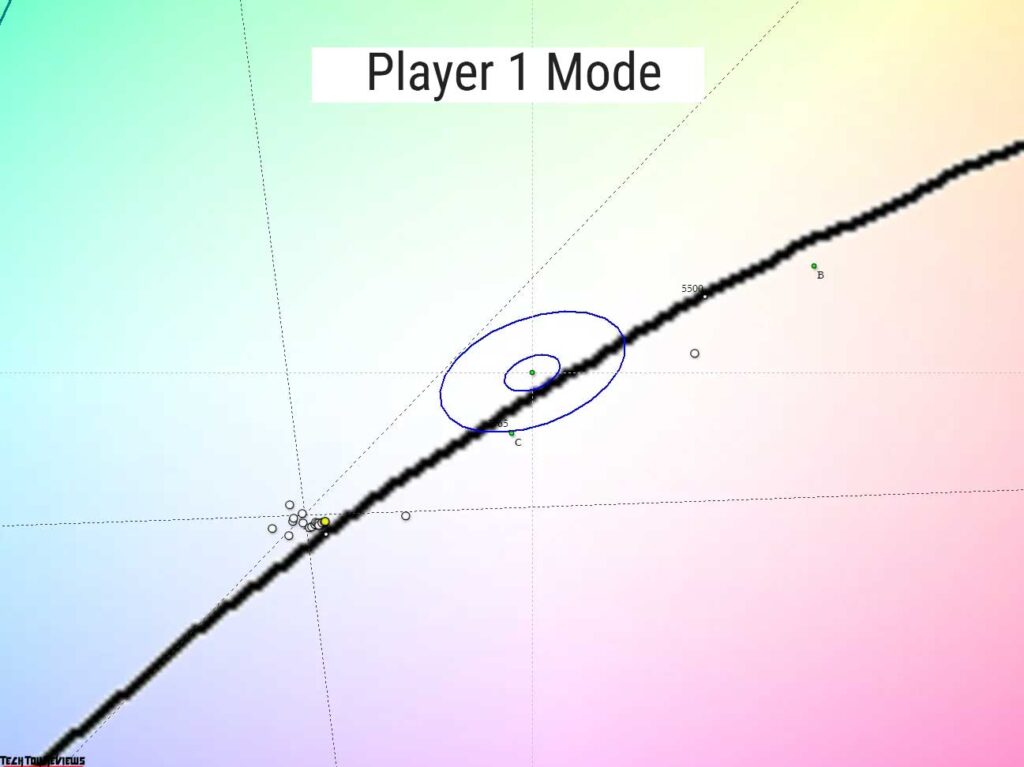
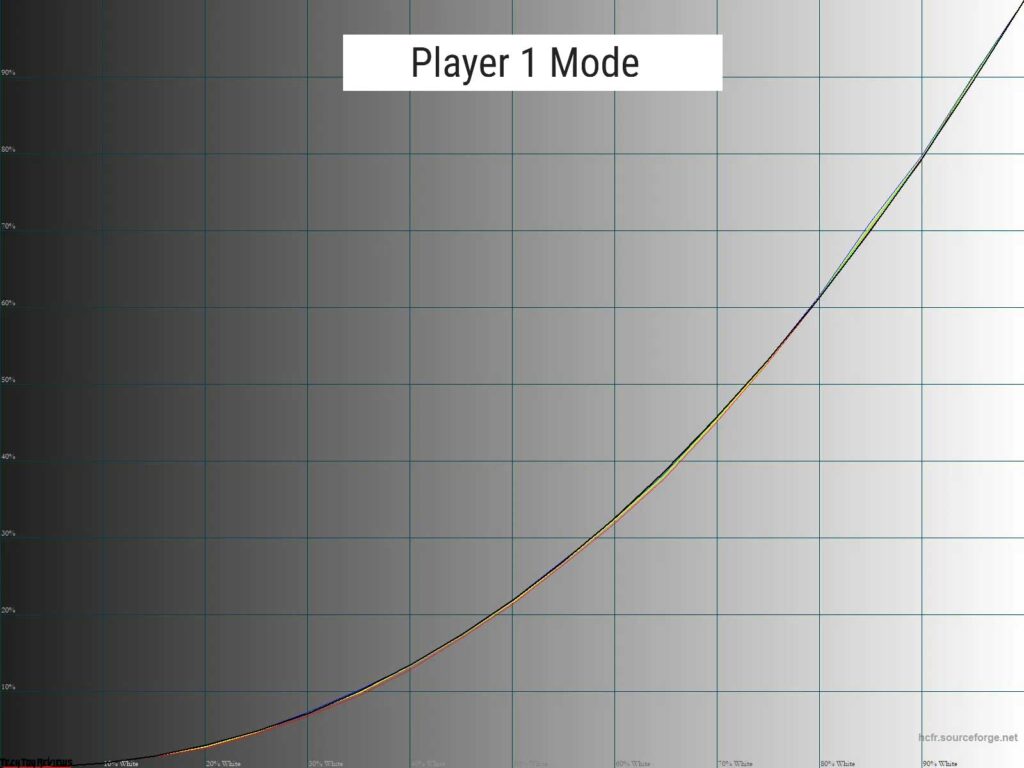
Under the standard settings, the measured gamma curves closely align with the desired gamma 2.2. There exists a slight RGB imbalance, yet the on-screen picture exhibits commendable contrast, with noticeable detail differentiation in shadows and highlights. However, the gray wedge points cluster together in the colder region of the CIE diagram, accompanied by a corresponding white point.
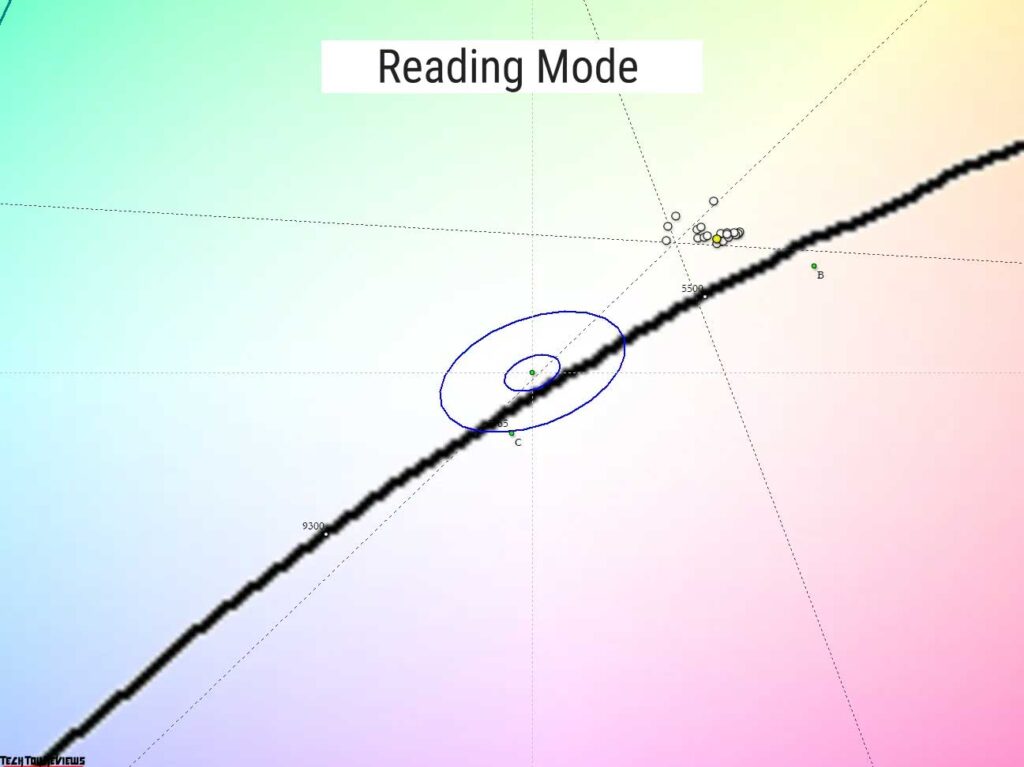
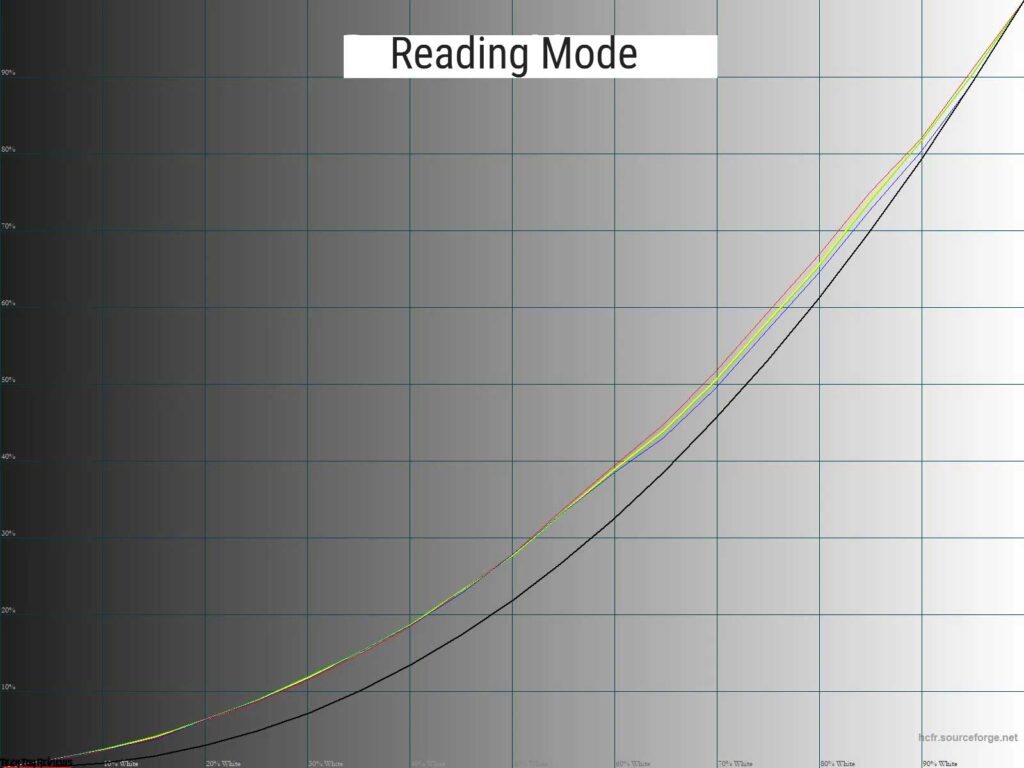
The Reading mode introduces dramatic changes in brightness and color temperature, serving its intended purpose remarkably well. It effectively reduces the load, achieved in part through a significant elevation of deep shadow areas, further diminishing picture contrast. Consequently, the “zero black” point experiences a considerable raise, leading to a drastic reduction in the contrast ratio.
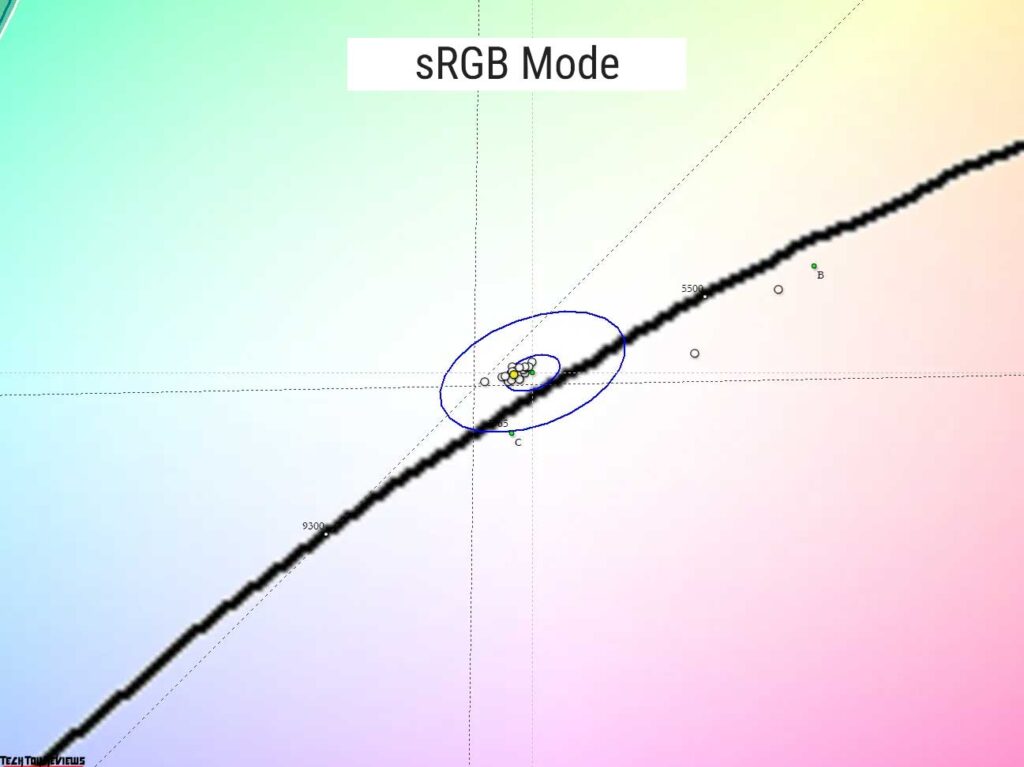
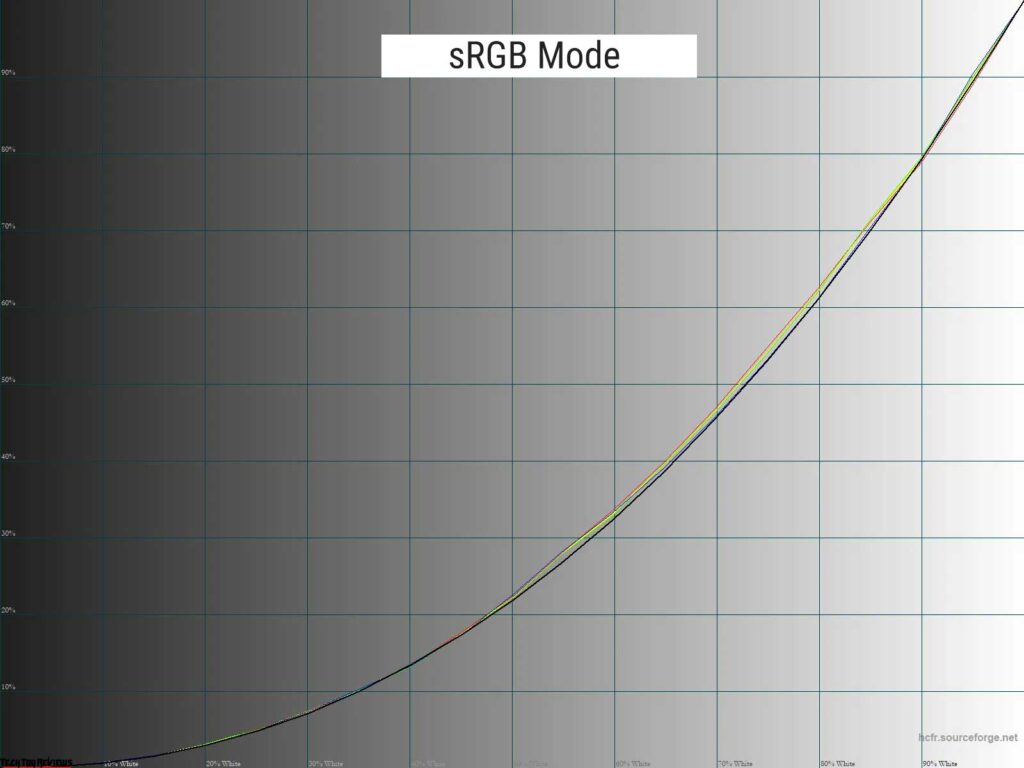
In terms of overall tuning accuracy, sRGB mode emerges as the most impressive. It adheres to the requirements of the corresponding standard for gamma curves, although the visibility of shadows falls slightly behind the factory-set Player 1 mode.
The sRGB Mode restricts the color gamut, albeit with some minor emulation errors. Nevertheless, the gray balance remains excellent, and users can freely adjust brightness across the entire available range, along with manual color temperature adjustments.
Gradient uniformity
We are gradually approaching the most intriguing aspects of LG’s new OLED monitor, and one notable feature is the gradient uniformity and tonal transitions, particularly in darker shades.
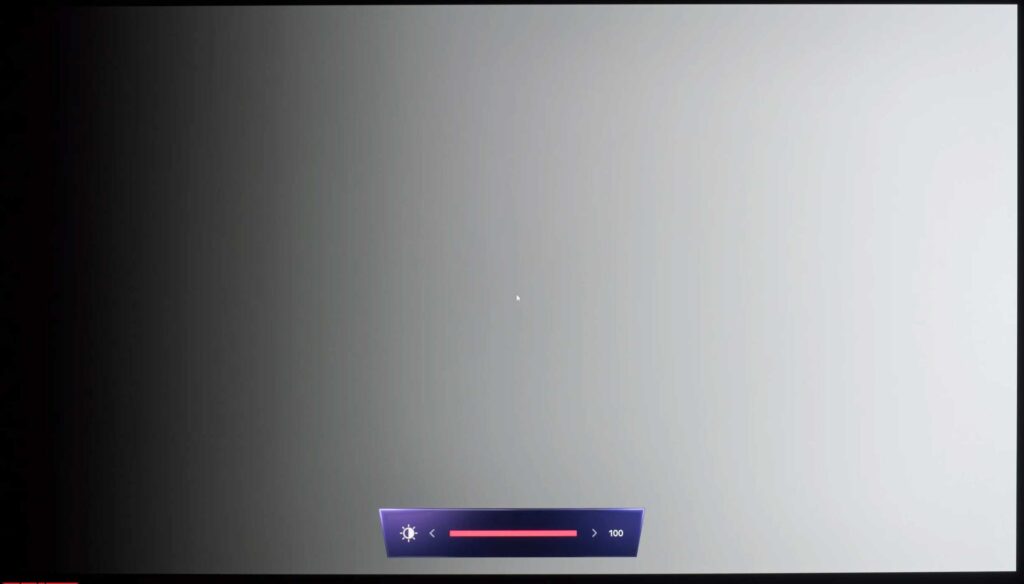
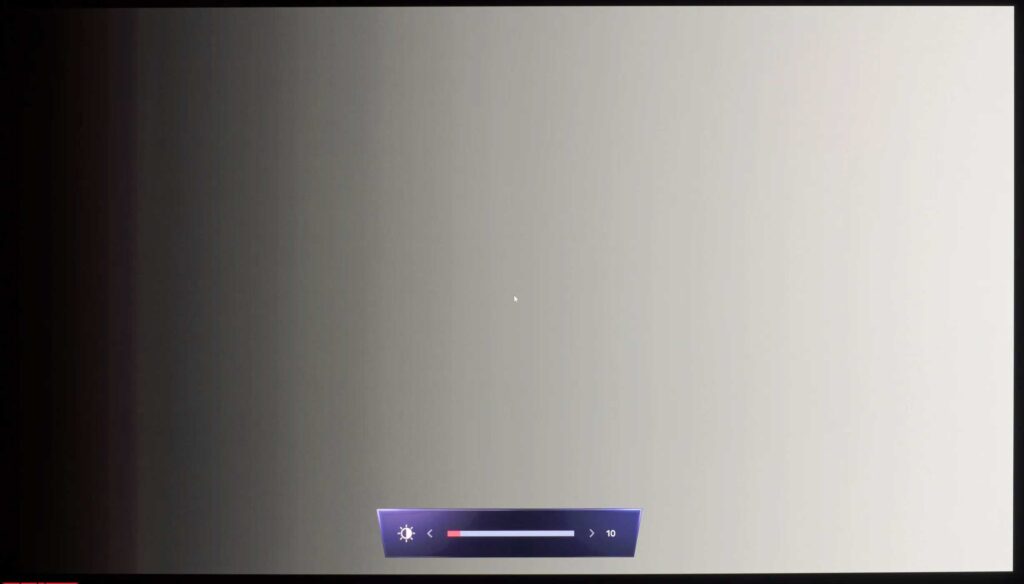
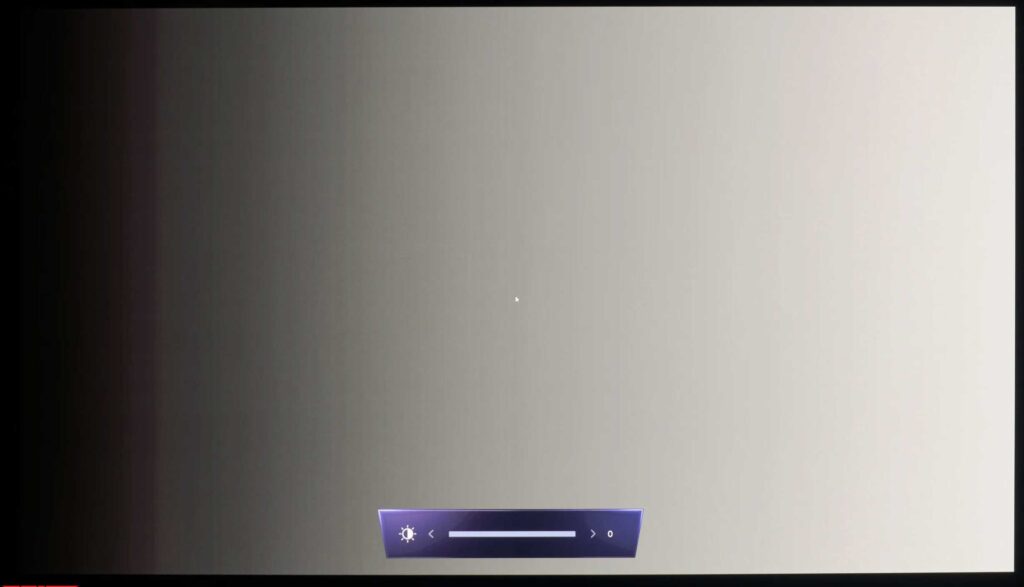
In its factory settings and most preset modes, the monitor exhibited subpar tonal transitions, especially in dark regions. Lowering the brightness only worsened the issues and restricted the dynamic range. The transitions appeared rough and unclear, with the presence of unwanted hues even without any LUT edits from the graphics card. Distinguishing between the darkest mid-tones was minimal or sometimes impossible.
None of the gamma modes yielded better results, and adjusting the “Black Stabilizer” actually led to noticeable deterioration. Increasing the bit depth to pseudo 10 bits and emulating a 12-bit signal (likely done internally by the monitor) had no impact on gradient quality. This is because the majority of applications operate in 8-bit mode (including the TFT test we employ). Hence, while color accuracy tests may yield positive results, the visual evaluation tells a different story. The 27GR95QE-B is not suitable for color-oriented tasks, despite any hopes to the contrary.
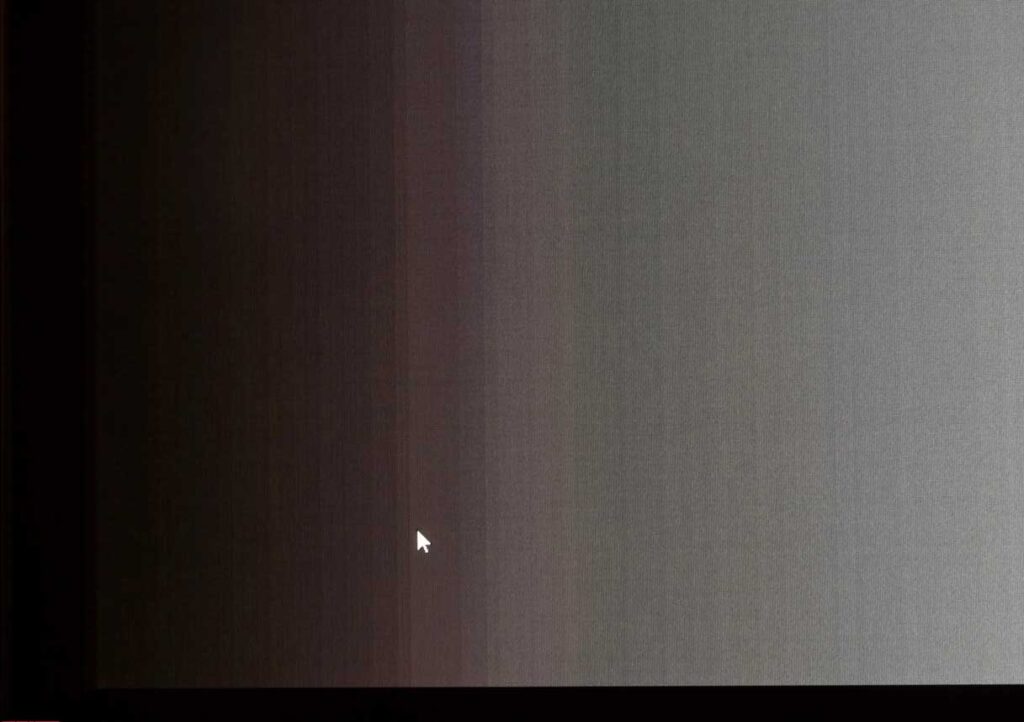
It’s worth mentioning that adjustments can be made due to the characteristics of image rendering on OLED panels. Dimming the brightness on the LG 27GR95QE-B reduces the dynamic range.

On the other hand, reducing the brightness intensifies OLED flickering, leading to the appearance of “gray noise” in dark gradient areas—an almost crystalline effect that becomes noticeable. The lower the operating brightness, the more pronounced it becomes. It’s important to remember that this is not exclusive to our LG 27GR95QE review unit; it’s a universal characteristic of all OLED screens, be it smartphones, tablets, TVs, or modern computer monitors like our LG 27GR95QE model. In the case of the LG 27GR95QE, various visual defects can be observed in dark fields, such as vertical, diagonal, or horizontal stripes, dots, and other anomalies. Enabling the “picture cleaning” and “pixel updating” functions can partially alleviate the issue, but it doesn’t completely resolve the problem. Keep this in mind to avoid surprise when encountering such phenomena.
Color temperature stability
Let’s proceed with our LG 27GR95QE review by examining the color temperature stability in standard and special picture modes.
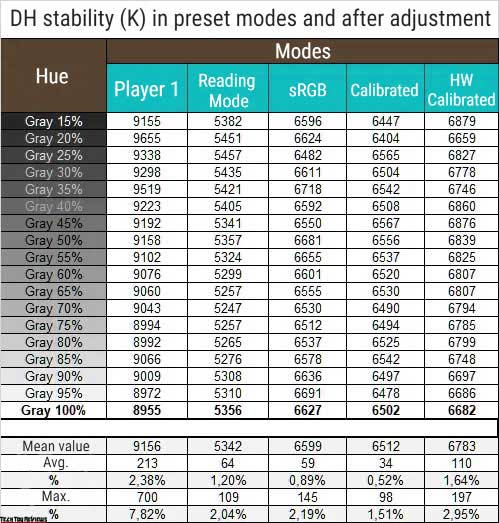
The table below presents the deviations of the gray wedge points along the X-axis, allowing us to evaluate the presence of unwanted hues using the CIE diagram from the “Gamma curves and gray balance” section. These deviations do not impact the vertical axis.
The color temperature stability at the factory settings was found to be average. In the other two preset modes, it reaches a high level, particularly in terms of average deviation values. After performing the usual calibration using the graphics card’s LUT, we achieved the highest result. However, hardware calibration through the monitor’s own LUT proved incapable of attaining such results.
Now let’s examine the outcomes of the special Color Temp modes. Remember that the default “User” preset has RGB values of 50/50/50. Hence, it’s important to note that the values in its column completely align with the results of the “Player 1” mode from the first table in this testing section. We’ll now discuss the remaining DH presets with different values and advanced white point settings from the “Instructions” subsection:
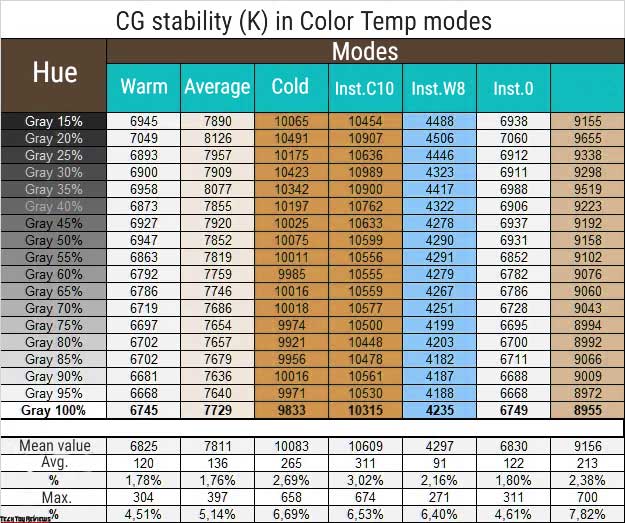
The following observations can be made:
- The factory settings, in an attempt to increase maximum brightness, result in a “cold” picture.
- The “Warm” mode is similar to “Instruction 0” in terms of both the color gamut itself and the level of deviations. It represents the most accurate mode for reducing eye strain and providing a neutral gray wedge.
- In contrast, the “Medium” mode lives up to its name, offering something average with satisfactory gray wedge stability.
- By fine-tuning the white point in the “Instructions” subsection, you can further expand the available range of color gamut. It allows you to choose from 10 “cold” and 8 “warm” options.
In conclusion, here’s our advice: if you don’t have to measure instruments for calibration, you can stick with the factory settings for slightly higher brightness or switch directly to the “Warm” mode, which is the most accurate for prolonged use. In other cases, choose a mode that visually suits you best, or adjust the RGB values manually or under the guidance of measuring equipment.
Contrast stability and brightness range
To assess contrast stability and the range of brightness adjustment, we selected the Player 1 mode. The Brightness value was varied from 100 to 0% in increments of 10 units. The measured values in the table below were obtained using the HCFR program, which provides a more accurate estimation of the black level (although it’s not highly relevant for OLED) and allows for a reliable contrast ratio determination.
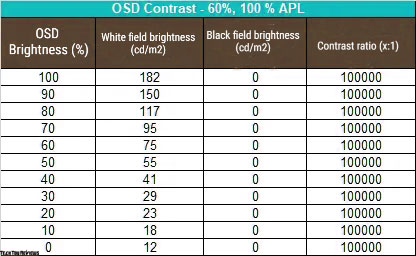
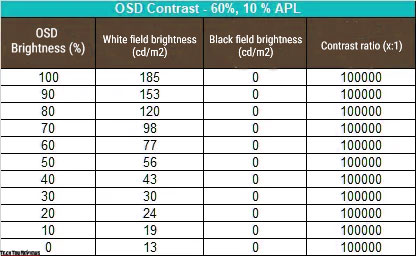
Considering that it’s nearly impossible to measure the depth of black in OLED displays, we immediately set a contrast ratio of 1,000,000:1 (1 million).
We conducted the tests with standard settings; however, increasing the contrast to 70% (as in sRGB mode) slightly elevated both the maximum and minimum values. All the values were initially measured with 100% screen coverage and then at 10% APL.
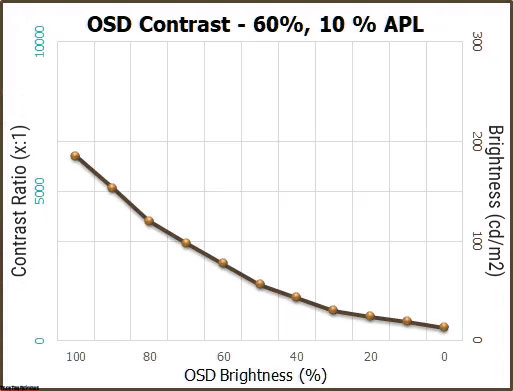
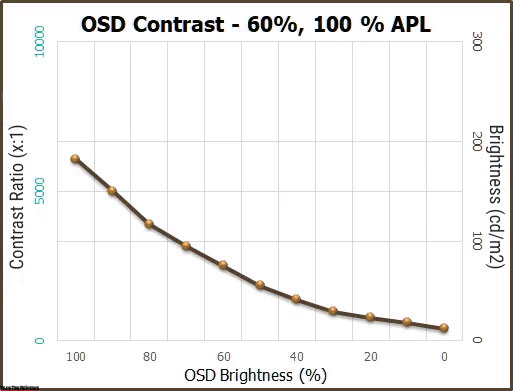
At standard settings, the resulting range of operating brightness was 12-182 nits, with an infinite contrast ratio. The brightness reduction is non-linear, and the operating range can be deemed comfortable when the LG monitor is used indoors without intense external lighting.
Narrowing down the measurement area to 10% of the screen did not lead to a significant improvement in the monitor’s performance. The maximum brightness increased to 185 nits, while the minimum rose to 13 nits.
It’s worth noting that, due to the characteristics of OLED, screen brightness fluctuates based on the volume of light output to reduce overall power consumption and protect the panel from accelerated burnout. This effect is visually noticeable with the LG 27GR95QE-B, and unlike a pricier ASUS monitor, LG lacks a brightness compensation system. Perhaps the company will introduce a similar option through future firmware updates, but the prospects for this seem limited.
Regarding the maximum capabilities of the LG 27GR95QE-B, when HDR was activated, the monitor, at default settings, could demonstrate a maximum of 604 nits at peak brightness and 2-10% APL. Surprisingly, even switching to the “Bright” mode didn’t surpass this figure, despite slightly different white point settings. The result was even lower, despite having the latest available firmware for the monitor, which many tech-savvy users had high expectations for.
However, it’s important to note that many reviewers have encountered similar behavior with LG monitors, so there are no groundbreaking revelations here. One thing is clear: the higher the color temperature (cooler picture), the higher the OLED monitor’s maximum brightness. If you adjust the monitor to more reasonable DH values, the brightness results will be lower, but they won’t hinder comfortable work or enjoyment of entertainment content.
Display speed and frame drop
OLED technology possesses remarkable capabilities in terms of response time for brightness changes (pixel/subpixel color), which is why it has been eagerly awaited by many gamers. In the case of the LG 27GR95QE-B, the manufacturer claims a GtG (Gray-to-Gray) response time of 0.03 ms and a maximum vertical frequency of 240 Hz without the need for additional overclocking (meaning this frequency is native to the panel). While the latter figure may not surprise anyone in mid-2023, the claimed response time is 30 times lower than that of the majority of gaming LCD monitors, making it quite impressive.
Our LG 27GR95QE review unit does not employ Overdrive technology nor does it have a “black frame insertion” system, which is known to be effective in OLED displays and can be found in many modern LG TVs based on W-OLED technology but with a lower vertical frequency. As a result, users have no options to adjust the response time or enhance their visual experience with additional technologies like BFI (Black Frame Insertion).

The significant reduction in response time compared to gaming TN + Film and IPS displays, even at higher refresh rates, was expected to deliver a markedly different visual experience. Many reviewers have confirmed that OLED and QD-OLED monitors and TVs exhibit an average response time of 0.05-0.3 ms, whereas the average for the fastest LCDs is around 3-4 ms. Hence, the real difference of approximately 10-30 times, as indicated by the data and measurements, is preserved. However, the actual measurements and impressions turned out to be quite different. LG’s OLED display doesn’t handle motion well, making it challenging to read text on a moving image (as seen in the provided photo), and there are slight artifacts on certain object outlines. While there may be no complaints about the speed capabilities of the new 27GR95QE-B, the difference promised by the numbers and anticipated by most consumers simply isn’t there—don’t even hope for the opposite. High-quality high-speed IPS displays operating at 240-280 Hz and TN + Film displays with Ultra Fast IPS technology at 360 Hz will impress you with their visual speed just as much.
This is now the third OLED display we have reviewed, and it has become evident that achieving the lowest possible response time does not guarantee high smoothness. While noticeable trails and artifacts may be absent, the level of clarity falls short of what can be achieved by high-speed LCDs with the “black frame insertion” system.
Lastly, let’s discuss the 240 Hz refresh rate. There are no frame drops when operating at this frequency, as confirmed by a dedicated test from the TestUFO package. During continuous operation, there were no issues, and the frequency remained stable.
Viewing angles
Having reviewed the LG 27GR95QE-B, we can confidently affirm that OLED technology excels in terms of viewing angles and picture stability, as demonstrated by this monitor.

The image provided exemplifies this fact perfectly. Even when the viewing angle is adjusted within a wide range, the brilliance and brightness of the picture on the LG OLED screen undergo only minimal changes, maintaining a consistently high level.
Brightness uniformity and color temperature
The uniformity of monitor brightness and color temperature across the screen field was thoroughly tested at 35 points, with the monitor brightness set to 100 nits and displaying a full-screen test field (100% APL). All calculations and deviations were based on data from the central point. It’s important to note that the monitor does not utilize a brightness compensation system.
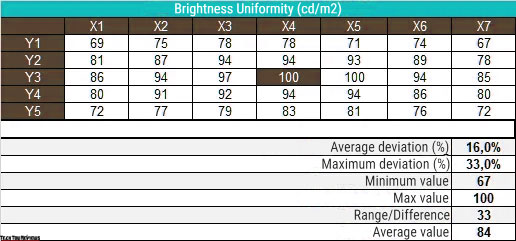
Surprisingly, with the brightness set, we observed an average deviation of 16% from the center point and a maximum deviation of 33%. This result caught us off guard. It appears that LG engineers aimed to simulate the working field uniformity found in conventional LCDs, possibly to reduce power consumption and heat dissipation of the display. We can’t find any other reason why the brightness would dim in the peripheral areas of the relatively small OLED screen. Comparatively, when testing larger QD-OLEDs with a panel from Samsung, we obtained results averaging around 1-2% and a maximum of 5-10%.
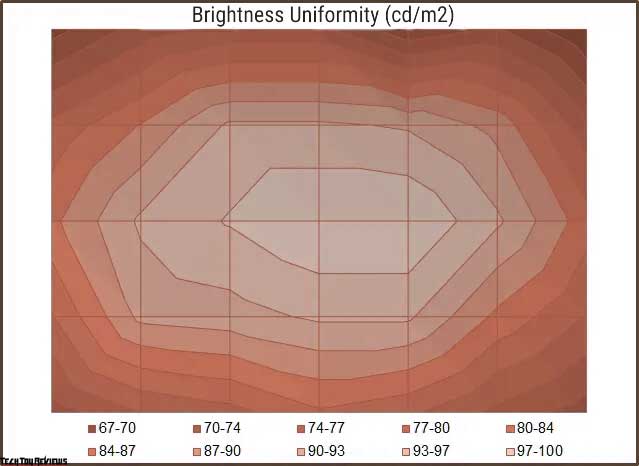
The provided surface diagram showcases the concentration of brightness level over the screen matrix field. In our LG 27GR95QE review unit, the manually adjusted brightness setting is preserved only within a small oval area at the center of the screen. As we move farther away from the center, there is a greater decrease in brightness, but the issues with color temperature are more noticeable than those related to brightness.

The above photo illustrates a white field with minimal edits made in a graphical editor to visually represent the bright field uniformity on the screen.
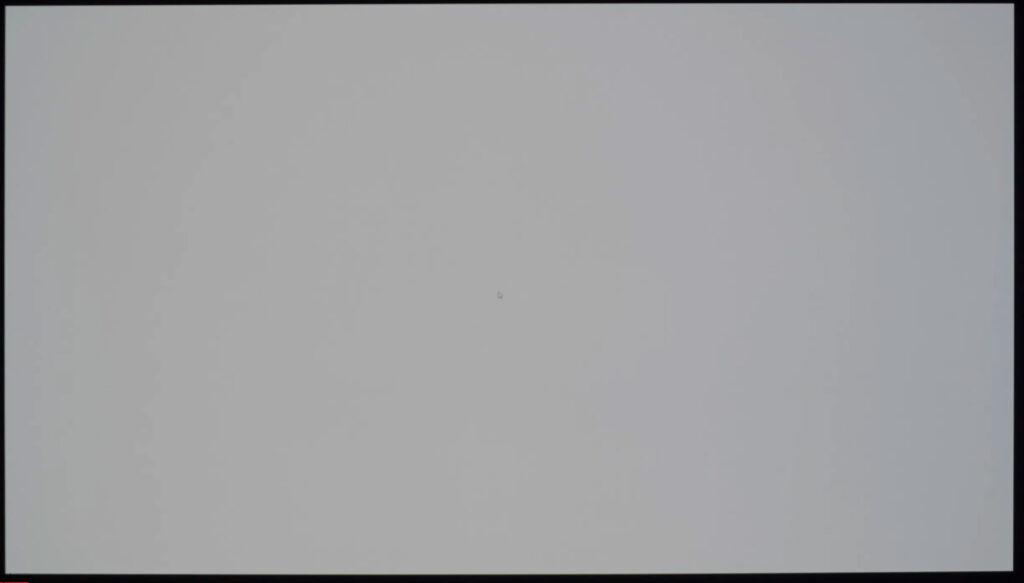
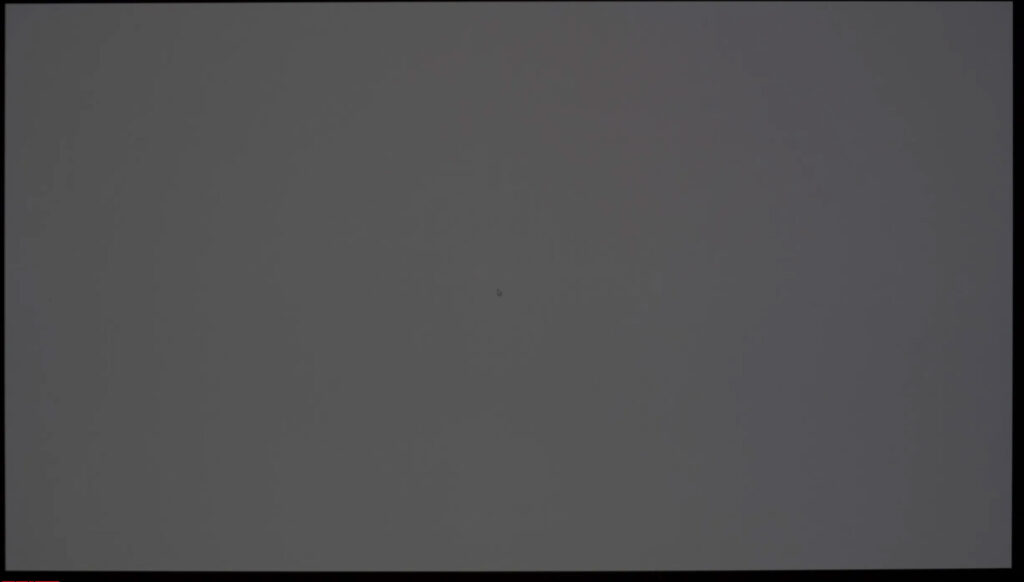
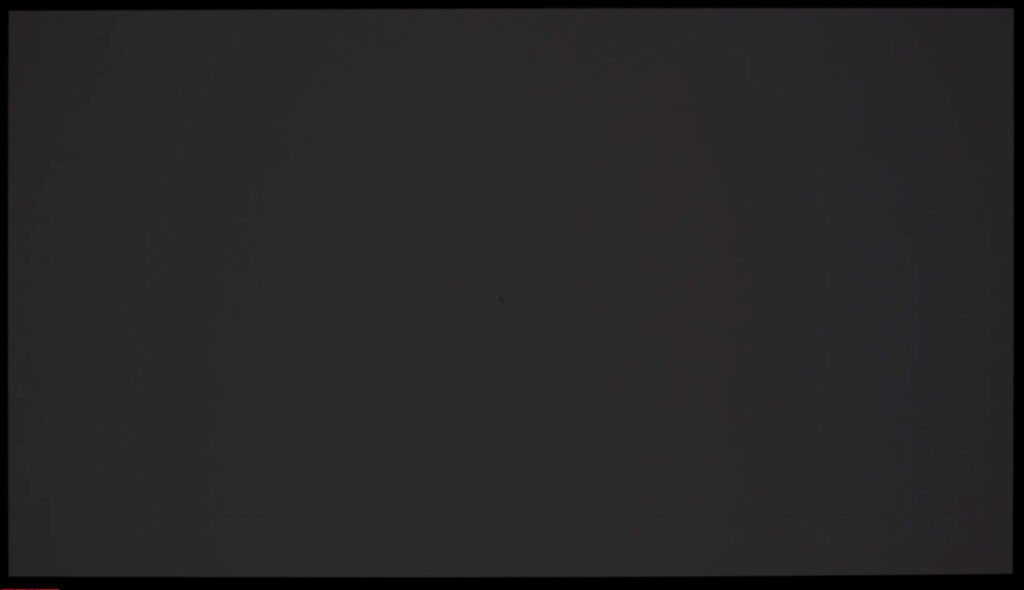
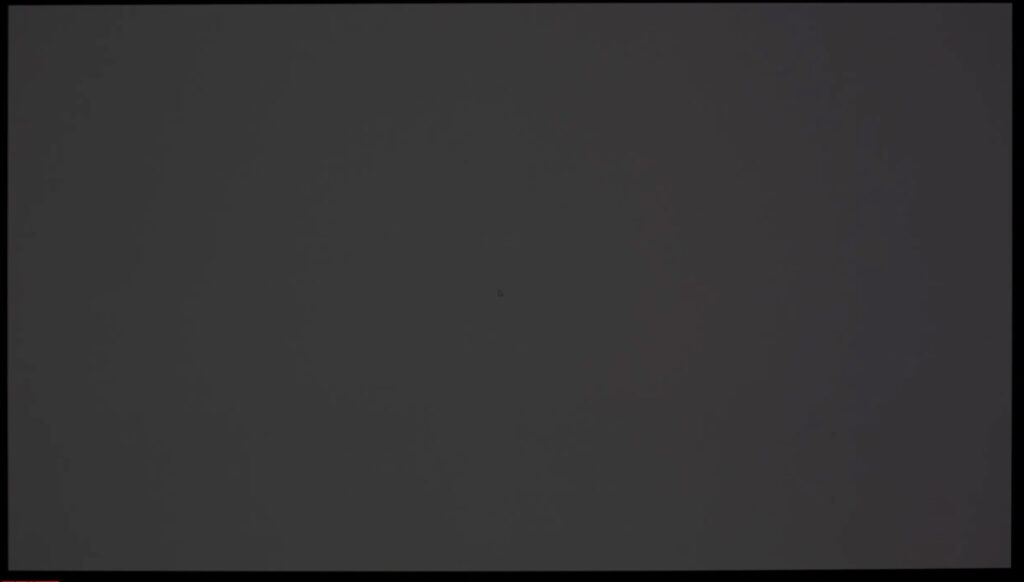
To further enhance the effect and gain a better understanding of the backlight uniformity, we captured four photographs of gray fields. The visible problems primarily revolve around the unevenness of color temperature. Notably, there is a noticeable change in color temperature from one part of the screen to another, with an increase observed from left to right.

When it comes to a black field, as we previously mentioned, there are no issues—when displaying 100% black, the pixels on the screen turn off, leaving only a small area with a white mouse cursor as a witness.
Now let’s delve into the examination of color temperature uniformity across the entire screen area.
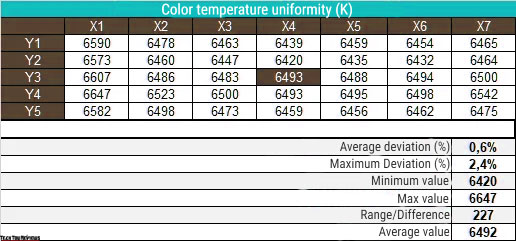
During our LG 27GR95QE review, we employed manual DH settings to achieve a target of 6500K, with the center white dot remaining at 100 nits. The resulting average deviation of 0.6% and a maximum deviation of 2.4% may seem high, but surprisingly, the visual impressions and the photos provided differ significantly from what we obtained during the measurements. This leads us to ponder whether LG’s OLED is inherently unstable or if something else is amiss. Currently, we are leaning towards the former, as OLED tends to exhibit unpredictability during testing.
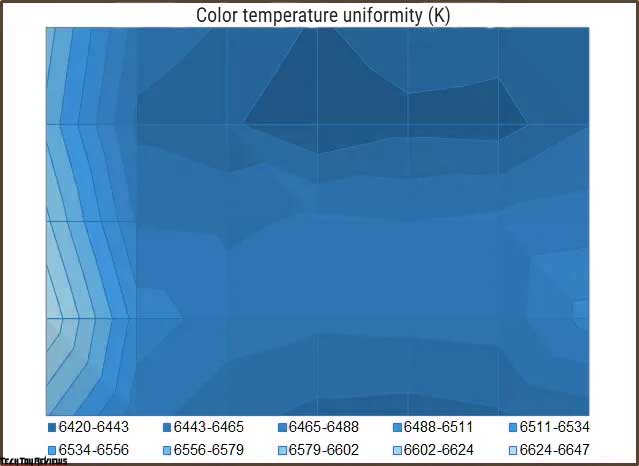
Based on our measurements, the central heating uniformity of our LG 27GR95QE review model is problem-free. The only “issue” area is the left edge of the panel. However, considering the maximum difference in DH of 227K across the entire panel surface, this minor discrepancy can easily be disregarded. It’s important to keep in mind and consider the gray field photographs that do highlight some problems.
Final line
Let’s conclude the LG 27GR95QE review article, we have chosen to avoid overwhelming you with excessive technical information and repetitive statements. Instead, we will simply discuss the prospects of future OLEDs, their intended purpose, and the specific tasks that the LG 27GR95QE-B from the UltraGear gaming series is well-suited for.
Many consumers perceive OLEDs as something extraordinary, a replacement for all types of LCDs combined. However, this is a misconception. OLED should be regarded as just one branch of screen matrix development, albeit a somewhat delayed one. OLED is not flawless, just like any other type of liquid crystal display technology. Let’s reiterate: OLED is not a substitute for IPS/VA. It is fundamentally different.
To reduce production costs, modern LG OLED monitors utilize the well-established W-OLED panel with its unique pixel structure. This structure does not compromise the rendering of deep “infinite” black or the maximum color saturation. All the desirable features that consumers appreciate remain intact. The high pixel response speed is not compromised either. However, certain drawbacks persist, negatively affecting rendering clarity, causing issues with tonal transitions, reducing dynamic range during brightness adjustments, and more.
Due to various factors, gaming OLEDs are significantly less versatile than gaming LCDs. They excel in entertainment applications such as movie-watching and viewing various videos, especially in high-quality HDR performance for an enhanced visual experience. They are also suitable for relatively short gaming sessions, including competitive gaming, where speed, clarity, and HDR support are crucial. In all of these cases, the 27GR95QE-B model, if the 27-inch WQHD format meets your requirements, surpasses nearly any IPS monitor at the same price point or even higher.
If your budget and desk space permit, consider combining both an LCD and an OLED monitor for the best setup. This configuration offers benefits such as excellent color accuracy, hassle-free operation, and reduced eye strain through modern flicker-free backlighting and a safe working spectrum. You can comfortably read and work on documents for extended periods without concerns about burn-in or image defects that may occur over time. Reserve the OLED display for other purposes, maximizing its capabilities. In summary, the LG 27GR95QE review highlights its strengths and suitability for different tasks, showcasing its impressive performance in the UltraGear gaming series.
Price and availability
The LG UltraGear 27GR95QE OLED gaming monitor is available for purchase on Amazon.com and Amazon.co.uk at a price of $999.99.
| Preview | Product | Rating | Price | |
|---|---|---|---|---|

|
LG 27" Ultragear™ OLED QHD Gaming Monitor with 240Hz .03ms GtG & nVIDIA® G-SYNC®... | $992.27 | Buy on Amazon |
 Technology News, Reviews and Buying Guides review, monitor review, tablet review, laptop review, mobile review, smartphone review, buying guide,
Technology News, Reviews and Buying Guides review, monitor review, tablet review, laptop review, mobile review, smartphone review, buying guide,

